METRO
Newton North Principal Henry Turner creates conversation spaces for students to discuss critical social issues such as race. A4

Newton North Principal Henry Turner creates conversation spaces for students to discuss critical social issues such as race. A4
Former U.S. Senator Doug Jones, the current Jerome Lyle Rappaport distinguished visiting professor at Boston College Law School, will act as a “sherpa” for President Joe Biden’s Supreme Court nominee, guiding them through the confirmation process in the Senate.
“I’m taking a leave of absence from everything except my Boston College School of Law gig and will become an adviser to the president regarding the … Supreme Court nomination that’s coming up, so I’m very excited about that,” Jones told The Heights on Eagle Eye.
After defeating Republican Roy Moore—a former judge accused of sexually assaulting minors—in a 2017 special election, Jones became the first democrat to hold a Senate seat in Alabama since 1997. Jones is also a former U.S. Attorney known for prosecuting two members of the Ku Klux Klan for the 1963 Birmingham church bombing that killed four Black girls in the late ’90s.
Ken Kersch, a political science
professor at BC, said Jones’ political experience and Alabama upbringing could have been factors in his appointment to the role of “sherpa”—formally titled the nomination advisor for legislative affairs.
“It seems to me obvious that he’s someone, first of all, who has a lot of political skills and has served in the Senate with many of the senators on both sides of the aisle, and he is respected and well liked,” Kersch said.
The advisor role serves to establish connections between the nominee and senators who will ultimately vote to confirm them, according to Kersch.
“So the guide, especially in the case of Jones, is a political job,” he said. “Its job is to introduce the candidate to individual senators, in significant part, [to] find common ground.”
R. Shep Melnick, a political science professor at BC, said the advisor role may also have to strategize about media coverage and prepare the nominee for congressional hearings.
www.bcheights.com Chestnut Hill, Mass.
Deputy Managing Editor Emma Healy shares her recipe for raspberry swirl scones. A7

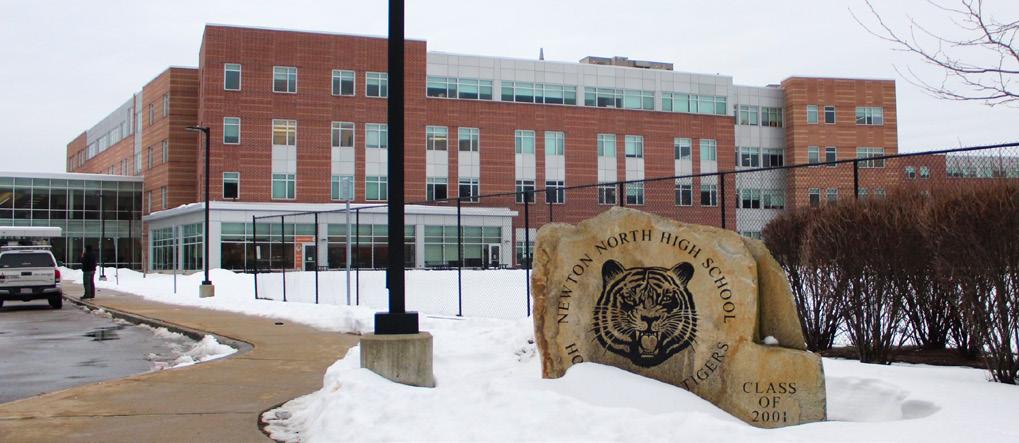 BY JULIA KIERSZNOWSKI Special Projects Editor
BY JULIA KIERSZNOWSKI Special Projects Editor
Boston College and the Jesuit Parish of St. Ignatius of Loyola have begun discussions “to explore deepening the partnership” between the
University and the parish, according to a letter addressed to parishioners on Sunday.
“ e bene ts to the parish range from collaboration on spiritual and educational endeavors to help with parish facilities and operations,”
reads the letter, which is signed by the parish pastor Joe Costantino, S.J., and the Parish Pastoral Council.
“With the support of the Jesuit Provincial, the pastoral leadership of St. Ignatius Parish and Boston College have opened discussions to explore deepening the partnership we already enjoy and bringing it to a new stage.”
Since its founding in 1926, St. Ignatius Parish has operated as an entity separate from BC, falling under the leadership of the Archdiocese of Boston. Despite this separation, there has been much collaboration between the two institutions, Costantino said in an interview with e Heights.
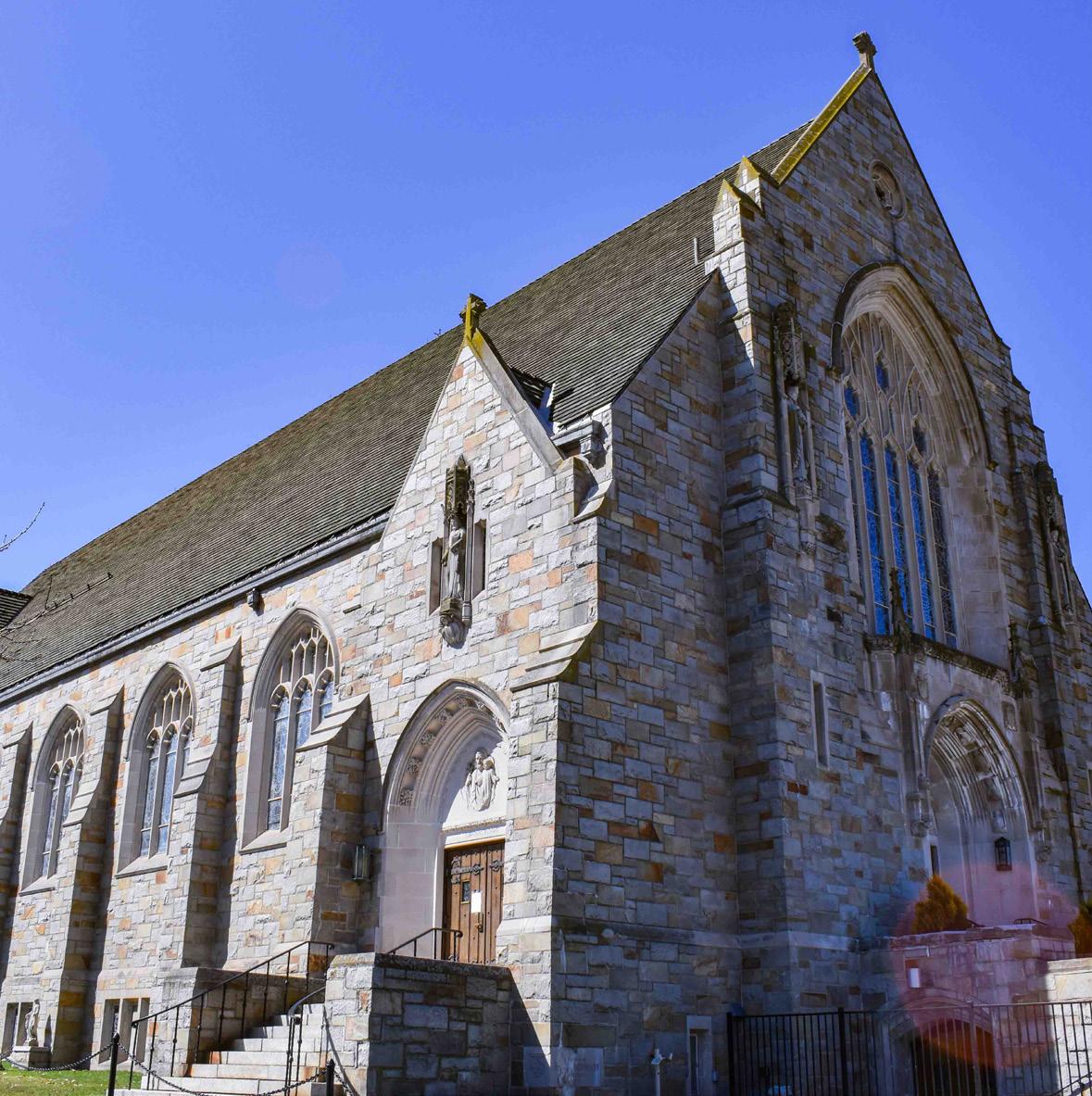

“BC uses the church for all sorts of programs, classes, [and] masses,” he said. “Many of the weddings and baptisms we do are also of BC alums. And all our internet, our emails, are all BC. ey help with our buildings and help with consulting about different things. … So there are so many ways in which we have collaborated with these di erent programs and o ces here at the school.”
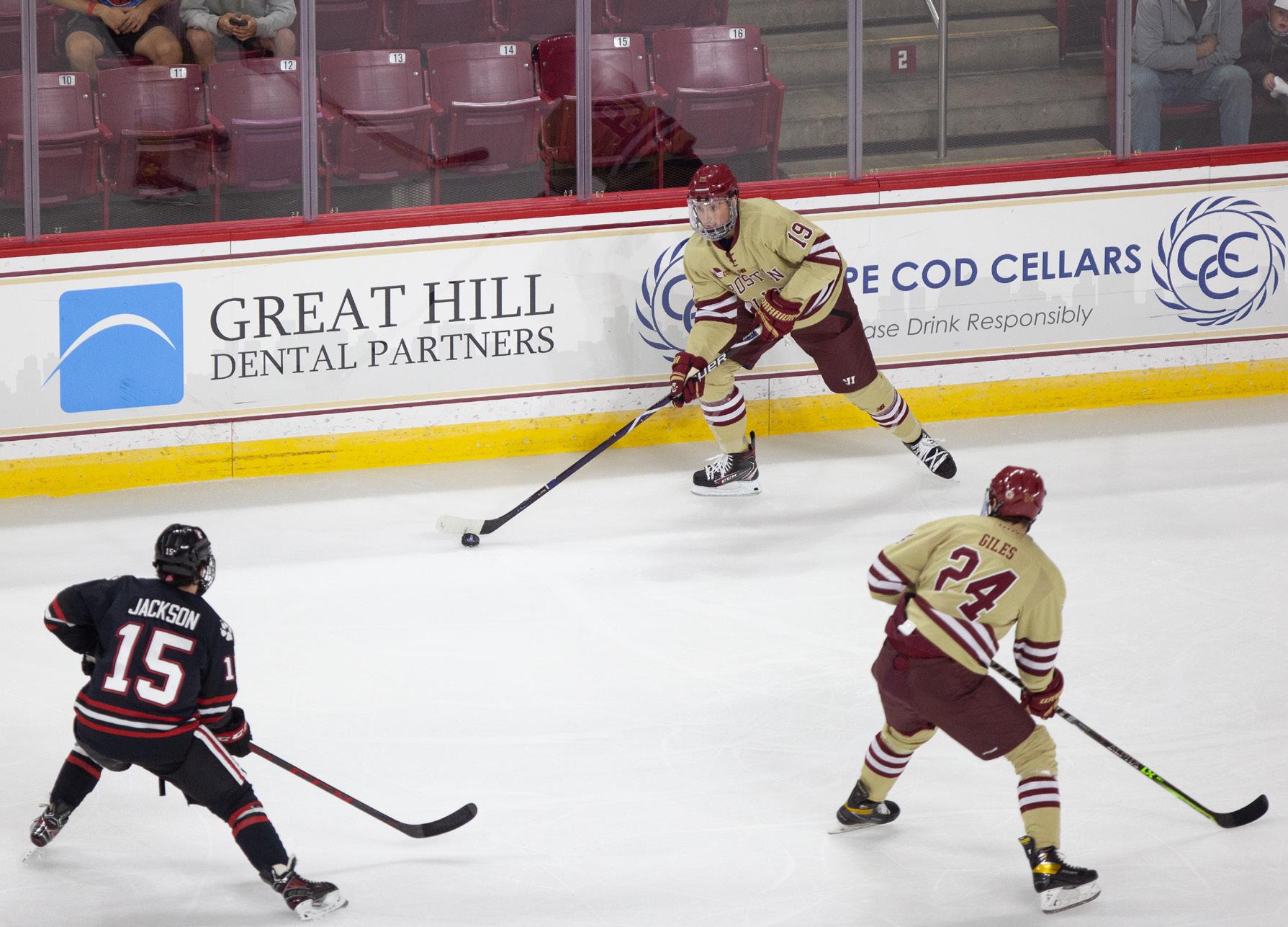 BY JOSIE MCNEILL Assoc. Arts Editor
BY JOSIE MCNEILL Assoc. Arts Editor
Walking into the McMullen Museum of Art’s new exhibit, Martin Parr: Time and Place , visitors encounter a photograph of Parr’s head protruding from the mouth of a shark, offering immediate evidence of the artist’s unique perspective.
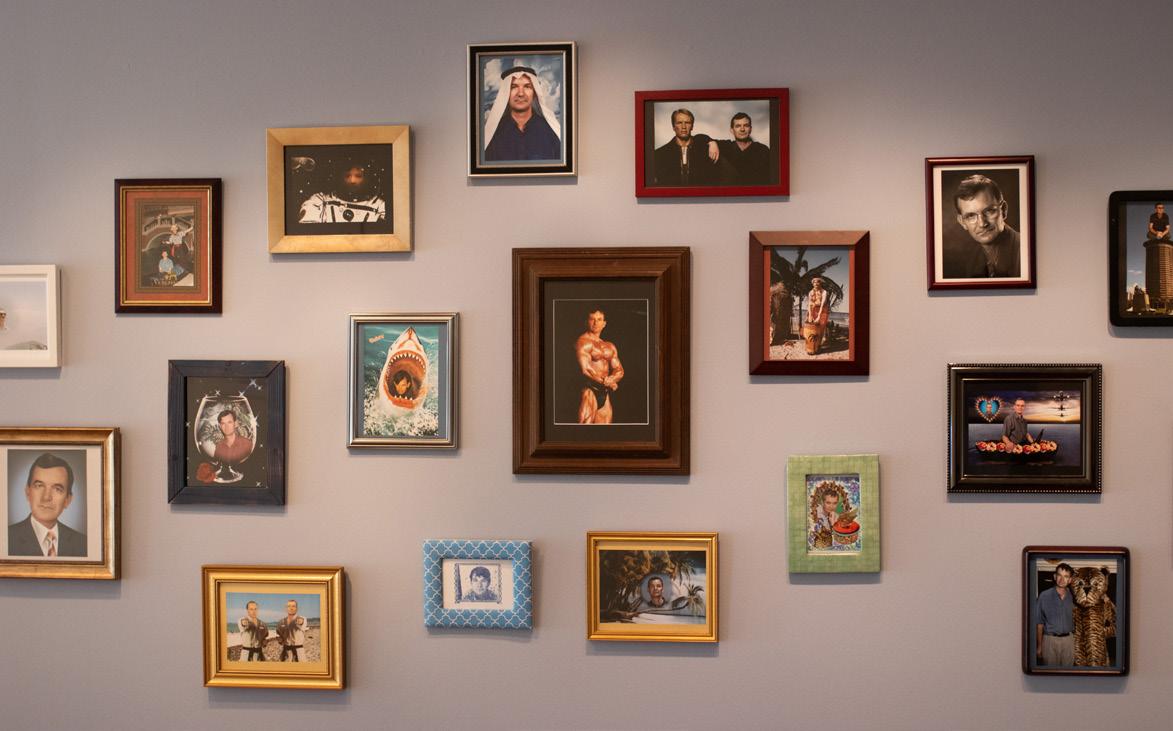
The exhibit, which opened at the
McMullen Museum of Art on Jan. 31, is the most comprehensive show of Parr’s work on display in the U.S. Through the lens of Parr’s camera, the photographs in the exhibit, which will be open through June 5, portray themes of the modernization of Ireland and the impact of tourism.

from A1
“They’ll have a series of mock hearings, in which some of the people on the team will play Republican senators, shooting questions at them and helping them try to figure out how to respond to these questions in ways that will be beneficial,” Melnick said. “So it’s pretty intense training that these nominees have to go through.”
Melnick said there are various unknowns that could harm the nominee’s chances, ranging from their personal background to Republican strategy.
“The sherpa—Doug Jones—is not going to know the strategy of the Republicans, whether they’re going to fight tooth and nail or whether they like to basically go through pro forma opposition,” he said. “They’re not going to know what kind of issues Fox News is going to raise and that they’ll have
to respond to.”
The challenge for Jones and the White House is the increasingly partisan confirmation process, Kersch said.
“There’s a lot of hardball tactics,” he said. “The votes are increasingly lying along on a partisan basis, and so many people have suggested that if [the confirmation process is] not broken, [it’s] not in one of its more collaborative and cooperative stages.”
Jones said that as the confirmation process has become more polarized, so has the Supreme Court.
He compared the current confirmation process to a political campaign.
“You will see millions of dollars being spent on political ads in states where they think that a senator can be swayed one way or another, and that gives the appearance of politics
in a big, big way,” Jones said. “So … I worry about the perception of the court. I believe in an independent judiciary, and I worry that has not been the case as much over the last few years, and I can understand why the public sees that.”
The fact that Biden’s nominee won’t change the balance of the court might mitigate the intensity of partisanship in the confirmation process, according to Melnick.
“Basically, you have a liberal retiring and a liberal replacing him,” he said. “So it’s possible the Republicans would not put up a huge fight. It’s even possible, although I think probably unlikely, that the nominee … will get one or two Republican votes.”
Biden has promised to pick a Black woman for his Supreme Court nominee, which has sparked backlash from some Republicans. Kersh said this choice is the modern Democratic Party idea
that the Supreme Court should be a representative institution.
“This is going to be a bright, highly qualified candidate for the court, every bit as qualified as someone like Amy Coney Barrett or Neil Gorsuch,” Kersch said. “So I don’t think at the end, it will matter to the confirmation vote.”
Though Jones said he could not comment on Biden’s promise,
he pointed to his political and electoral history as an indicator of his reaction.
“I think if you look at my history in civil rights and … really significant vote I got among African American women [that] helped push me over the top [in my election in 2017], you can probably figure what my reaction is going to be,” Jones said.
Amy Donegan first organized Boston College’s Bank Week four years ago, when she said investment banks had begun to accelerate their recruiting timelines while pushing for increased diversity in hiring.
“ ere’s plenty of students who grew up around nance and came to BC with the goal of doing something like [ nance],” Donegan, assistant dean for undergraduate career advising at the Carroll School of Management, said. “ at’s not the target audience for a lot of these rms, as they’re looking for underrepresented students.”

e parish has selected ve parishioners who will serve as representatives in discussions with the University, according to the letter.
“At this time, discussions between the two teams are only just beginning,” the letter reads. “We are mindful of both your likely desires for communication from us as well as our need to have your input concerning this partnership.”
An even closer, more formalized relationship with the University could have many bene ts for the parish, the letter reads. With the support of BC’s resources, the parish could increase its impact on its surrounding communityimproving its e orts to address poverty, environmental, and justice issues in the Boston area, the letter said.
Costantino said that many already assume the church is a part of BC and that a partnership could be mutually bene cial to both parties.
“We’re an independent diocesan parish, but we’re the gateway to the campus, so most people think we’re part of BC,” he said. “And BC has the resources to help us with certain aspects of this. And also, perhaps, maybe expand how we collaborate together more.”
e letter also details some of the potential nancial bene ts of partnering with BC.
ese bene ts could include building repairs and the addition of o ces and other facilities, the letter reads.
“We also see the nancial strength of BC could provide new options for our community, including upgrades to our
facilities,” it reads. “Although the parish has been able to attend to the ongoing maintenance of the buildings, it is obvious that signi cant capital repairs or improvements have been well beyond our reach.”

ough the discussions will most likely take months, Constantino said the potential agreement could take many forms.
“So we’re exploring those things in the months ahead,” he said. “Maybe one day this would be a joint campus ministry-parish center associated with the church. … Not that this would become a University chapel, it would still remain a parish but, you know, have even more connection than we do.”
The Heights was unable to immediately reach the University for comment.
is year, Bank Week took place from Tuesday to Friday and featured a variety of panels and networking events where sophomores could interact with BC alumni in the investment banking industry.
“Investment banking is unique in the sense that almost all of their hiring comes through their intern programs, and their intern programs are recruiting in sophomore year, so it really creates a need to get our students ready,” she said.
Donegan said that Bank Week aimed to foster a welcoming environment, featuring events such as “Women in Finance,” “Black/Brown in Finance,” and “Being LGBTQ on Wall Street” to provide perspective and advice for underrepresented groups on navigating the industry.
“Networking with people, I learned a lot more about the diversity programs,” Remi Robertson, CSOM ’24, said. “I now know a lot of banks have women’s programs and, even if not a speci c women’s program, they have [women’s] organizations within the banks, which has been really interesting to learn.”
e Diversity Networking Reception on Friday morning also gave students a smaller space to network with bank representatives before the session opened up to the general student population.
“It helped with getting a personal connection with recruiters and [current] employees, and with guring out what they’re actually doing in the company,” Dhairya Dhamani, CSOM ’24, said. “So you get, not a scripted answer, but something that is more genuine.”
Since Bank Week caters to sophomores with limited nancial experience, Donegan said the Bank Week website provides a variety of resources, including networking tutorials, bank recruiting timelines, and free access to advanced technical interview preparation from Training e Street.
Students new to the industry also observed the structure and inner workings of investment banking.
Omer Tanvir, global co-head of campus recruiting at Goldman Sachs, gave an overview of the structure of an investment bank.
He explained that while investment banking is an industry, it is also a speci c division within investment banking rms.
“Most investment banking rms have about 20 different divisions within them, one of which is investment banking,” Tanvir, BC ’05, said. “ e rst thing that bankers do is give you advice when you want to buy another company or merge with another company, … The second thing they do is capital raising—they connect you with [investors] when you need money.”
Read the rest of this story at www.bcheights.com
Leah Thomas, one of two keynote speakers at Boston College’s annual Women’s Summit, first considered environmental issues from a racial lens while she studied environmental science policy in college.
“It was really hard for me to learn about … all these laws that are supposed to make our world a better place, meanwhile a lot of people back home are drowning in the smoke of tear gas,” omas said.
The BC Women’s Center held its eighth Women’s Summit virtually this Saturday. The event aimed to empower attendees through workshops, speeches, and discussions.
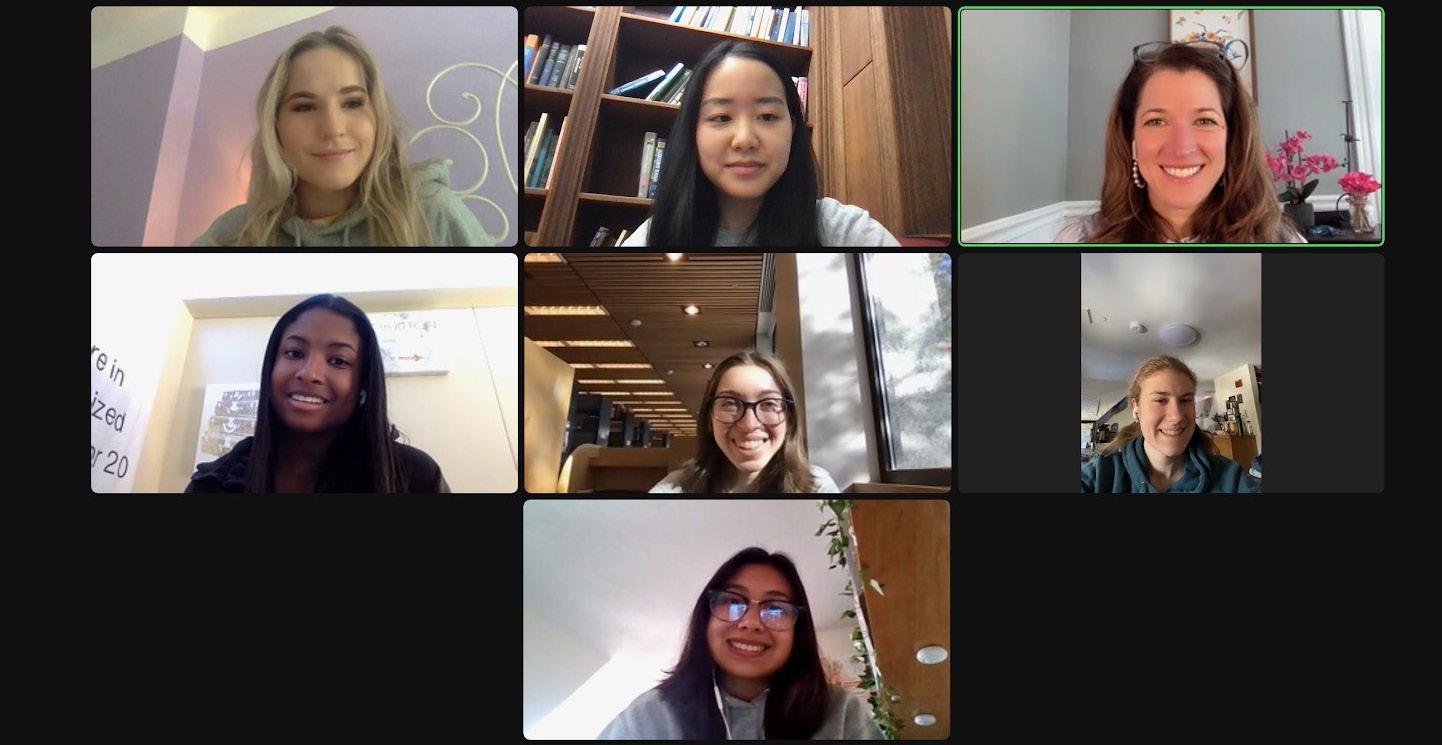
omas—the founder of an ecolifestyle blog called Green Girl Leah— started her speech by describing her path to environmental justice.
“I didn’t understand why my peers were focusing on this hypothetical future and not focusing on that urgency of environmental justice. … This is an act of environmental racism … If you do not care about the reality and the negative health impacts that are happening to people right now,” she said.
As an intersectional environmentalist, omas said she advocates for justice and inclusivity with environmental education, highlighting how low-income and
Black, brown, and Indigenous communities are experiencing the brunt of climate change.
“Communities of color and low income communities, especially when those two identities intersect, are continuously experiencing the brunt of environmental hazards and injustice,” Thomas said. “I started seeing statistics that state 70 percent of African Americans live in communities that are in violation of federal air quality standards.”
omas said she posted a pledge on her Instagram—which now has almost 230 thousand followers—that gained lots of attention.
“I posted on Instagram a definition of intersectional environmentalism, here’s the pledge if anyone wants to be an intersectional environmentalist, and I posted it online, and suddenly hundreds of thousands of people said they want to be [one],” omas said.
Later, alongside other activists, omas created the Intersectional Environmentalism Platform, a website to advocate for environmental and social issues with like-minded individuals from around the world, she said.
omas encouraged participants to focus on the intersections of race, gender, and income and how they compound to influence the way minorities experience the world around them.
“My identity in uences the way that I care for this world and this planet,” Thomas said. “You should never
have to silence parts of your identity to advocate for the causes that you care about.”
omas’ interview was followed by eight workshops which focused on topics including “Guiding Your Transition Adventure While Creating Your Personal Brand” and “Carving Out Your Path Towards a Meaningful Career.”
Sarah Kay—renowned spoken word poet, playwright, and founder of Project Voice—is a returning keynote speaker, as she also attended the 2019 summit.
Kay opened her speech with a poem about how her mother taught her to look for the color orange everywhere. e story, she said, is about how her mother’s positive outlook on life has inspired her.
“For example, while I spend my time getting caught up on the shittier parts of New York, my mother spends her time seeking beauty and following her curiosity,” she said. “I want to follow my mother’s example to look for what delights and to nd beauty that is easy to ignore.”
Kay then read another poem that questioned whether narrators are responsible for their reliability.
“Don’t just be someone who can observe and describe but use language for aspiration not inspiration,” she said. “Use language to speak something into existence and not just any old something.”
Admitting she felt pressure when asked to give this speech, Kay said she hoped to nd an appropriate tone of
positivity and wanted to be sensitive to the audience.
“We are all dealing on a daily basis with so much grief and fear and personal burdens visible and invisible, and it feels like a pretty tall order to nd anything of value to o er towards those e orts in your lives on most days,” she said.
Kay said throughout the pandemic, reading has helped her cope with her anxieties—she turned to the writings of other authors for an escape.
“It’s not about resolution or nding the answer,” she said. “You don’t need to condemn what you feel. … I like to pick up a book or listen to a podcast and see what’s going on in other people’s world.”
When asked by an audience member about whether her time off during the pandemic fostered creativity or posed challenges, Kay said the pandemic allowed for more introspective writing.
“I got to write poems that in
some ways felt really personal and honest in a way that was really freeing,” she said. “But this has been a really challenging time for everyone, and my creativity has definitely been challenged. So it’s been both challenging and fruitful.”
One of Kay’s concluding poems asked what a society would be like with a Minister of Loneliness. Kay said she got the idea after discovering that the Japanese government created a new position called the Minister of Loneliness in response to increasing suicide rates.
“Something about that was really inspiring to me,” she said. “I was thinking about what it would mean to try and take on that kind of work.”
Kay asked the audience to re ect on the poem and consider what kind of world they want to help create.
“ is nal poem is an attempt to look at what is but also to ask you to join me in giving a little time and attention to what else might be possible,” she said.
Valerie Lewis-Mosley, cocreator of the AHANA acronym at Boston College, said that she is neither a token nor the sum of her parts.
Her words echo the powerful sentiments spoken throughout the BAIC’s Black History Month Opening Celebration on Thursday night.

“[Black History Month] is more than a month,” Lewis-Mosley, the event’s keynote speaker and BC ’79, said. “It is more than 24/7, it is every fiber of your every day, of your every existence.”
As Gasson 100 filled with energetic music, the room transformed into a lively space for BC’s community to celebrate this year’s theme: “We Are One.”

“We must also not forget the richness of our culture and the vast representation in our diaspora,” said Kimberlyn Jones, one of this year’s Black History Month cochairs and CSON ’22. “Black love, Black joy, Black excellence means we are one ,means we are together.”
The celebration featured numerous Black student artists, many of whom read emotion-filled poetry and personal narratives.
“For me, my freshman year self defined excellence as a leader
who was engaged in everything on campus,” said Latifat Odetunde, BC’s 2021 Martin Luther King Jr. Scholarship recipient and MCAS ’22. “It is the same word that has been dehumanizing, where even today I struggled with knowing how to celebrate myself, since excellence is what is not expected.”
Odetunde encouraged the audience to join her in a series of affirmations and reflect upon what excellence means for each individual in the room.
“I am worthy,” Odetunde said. “I am important. I am love. I am Black excellence. Today I choose to celebrate me.”
The celebration repeated the theme of Black excellence throughout the night.
“Just among this Boston College campus there are infinite displays of Black excellence,” LewisMosley said. “There’s no single form of Black excellence because there’s no one single form of the Black identity.”
During her keynote speech, Lewis-Mosley reflected on her identity by recalling her experience as a nursing student and freshman resident in Fenwick Hall.
“Boston College taught me a lot in nursing, and I applied it to a framework that looked like me, sounded like me, was for me, and was by me,” Lewis-Mosley said.
Lewis-Mosley said that she attended BC through its Black
Talent scholarship program, which began in the fall of 1968.
Lewis-Mosley’s involvement in the program shaped her decision to mentor other Black students in the Connell School of Nursing, she said.
“I had a foundation that would not only allow me to succeed, but also help me to mentor others,” Lewis-Mosley said.
Lewis-Mosley’s keynote speech was followed by performances by multiple BC dance groups, including Sexual Chocolate, which performed step routines.
Other groups performed a cappella songs, including Louis
Armstrong’s “Go Down Moses.”
“We see dancers, we see poets, we see leaders, and we see changemakers, and within these, we see infinite subcategories which only resound the complexity of Black excellence,” Jones said.
Flyers provided at the ceremony gave a link to a document with a racial justice call to action, listing resources and actions to support the Black Lives Matter cause.
“When you know who you are, you value who you are,” LewisMosley said. “Watching the young folks here tonight reminded me that they were very clear about who they were, and whose they were.”
Afriendly face greets Newton North students every day as they walk into school.
Most days, Henry Turner, the high school’s principal, stands outside as students arrive.
“He would stand outside, like pretty much every morning before school, with a sign,” said Charlotte Paquette, a 2020 graduate of Newton North and MCAS ’24. “It would be like ‘Have a great day’ or ‘Make the most of everything’ and like really cute stu like that.”
In a conversation with e Heights, Turner said he is a principal that likes to understand the community he leads.
“I love school,” Turner said. “I love going to theater and games and, you know, award nights and all that stu . And I love the fact that we’re a community. We deal with our messiness, and we deal with our successes.”
Newton North hired Turner as its principal in 2016. Since then, the high school of more than 2,000 students has endured a pandemic and shifts in the country’s political climate.

In those tumultuous years, Turner has championed a one-to-one laptop program, bringing technology into the hands of every student. He has also created conversation spaces to talk about critical social issues facing his students. To students, he is a welcoming presence.
“If you saw him … he would have a smile on his face,” Paquette said. “He’s not a negative person. You’re not running away from the principal like, ‘Oh, I’m scared of that man.’”
Turner, now 43, grew up in Melrose, Mass. His experiences at Melrose High School, a predominantly white school, he said, motivated him to become an educator.
“I was one of the few people of color at my high school, and I was really driven by wanting to help make a di erence, particularly around racial justice,” Turner, who is Black, said.
Before becoming a principal at Newton North, another majority white institution, Turner was a history teacher. His classroom experiences, he said, continue
pal, I see my role as being an instructional leader [and] as helping to work with teachers around how to make sure that our classrooms are student-centered,” Turner said. Newton North Vice Principal Amy Winston said she remembers that Turner focused on classroom-level
helping to make sure that student voice is empowered—that students have a say,” Turner said.
versations last November after a Wisconsin court found Kyle Rittenhouse not guilty of intentional homicide and four other charges after he fatally shot two men at a Black Lives Matter protest in Kenosha, Wis.
In a blog post months earlier, Turner
strategies.
“I mean, it was frustrating,” Winston said. “ ough, what’s interesting about it … was attention from outside of Newton, and that the feedback we were getting from inside of town, generally was very positive and supportive of the work we were doing.”
change during his interview for the job.
“What most struck me, when we rst [met] … was his real focus on instruction as a driver of equity,” she said.
Even though Newton North is a large high school, Turner makes an e ort to get to know students as individuals, according to Winston.
“Our jobs are such that you could spend all day and never see a kid,” she said. “And I think Henry does really go out of his way to get to know individual kids and make as many connections as possible with kids.”
In addition to keeping the school safe and collaborating with teachers, Turner’s main job is focused on his students.
clubs, assemblies, or the curriculum, he said the school has made space for student conversation.
For Paquette, conversations on topics of social justice regularly occurred in her classes.
“[I was in a class on] women in literature, and we had a lot of those types of conversations,” she said. “Even like our psych class had those types of conversations.”
e school also harbored conversations after the 2017 Las Vegas Shooting, Turner said.
“I’ve seen that before when the shooting happened in Las Vegas years ago,” he
said educators need to create spaces that are safe for all students.
In response to the post, Breitbart News reporter Breccan ies criticized Turner, writing that he leads his high school on the idea that race is more important than anything else in American life. ies wrote that the Newton North High School principal seemed to administer his school based on a tenet of critical race theory following his response to the shooting.
In addition to writing the article on Turner, ies wrote that Chassity Coston, a Black principal at Bigelow Middle School in Newton, hosted segregated safe spaces following the Rittenhouse verdict. Winston said Breitbart targeted Black principals in its articles.
“My daughter goes to one of the middle schools in town … and her principal did the exact same thing,” Winston said. “She’s a white woman and didn’t get any of the pushback that our other principals of color and Henry got after the kinds of lessons and safe spaces we provided.”
ies’ article put a national spotlight on Turner, but following the public pushback the article generated, the principal said he felt supported by the Newton North community.
“ ere was outside media that was really trying to create a false narrative about what we did,” Turner said. “And I think as people heard about what we did, I think there was a lot of pride that we are a school that isn’t going to shy away from students having an opportunity to process current events.”
Winston also said the local community responded positively to Turner’s
about
issues at Newton North do not just come after national events.
In September 2016, just weeks into Turner’s rst school year on the job, students drove down Tiger Drive, the school’s main cul-de-sac, waving a Confederate ag, he said. e event attracted media attention. Paquette said she felt confused following the incident.
“Why is this happening here?” she said she recalled thinking. “[It was] just kind of bizarre.”
e school held a rally, created public artwork, held theatre productions centered on social justice, and created an “Action rough Literature” course in response to the incident, according to Turner.
“In that moment, our students rallied around to come together to say, ‘ at’s not who we are as a school,’ in very di erent ways,” he said.
In the future, though, there are even more ways the school can come together, Turner said. According to its website, Newton North o ers three di erent levels of classes: college prep, advanced college prep, and an honors level that includes Advanced Placement courses. Turner said the classi cations prevent some students from ever interacting with one another. ere are stories I’ve heard for years where you get into a senior class and two seniors would say, ‘Hey, we haven’t taken a class together since elementary school,’ because of our leveling system,” he said.
Bringing more students together at the school can help give Newton North a greater sense of community, Turner said.
“How do we make sure that there’s more opportunities where students can learn from each other—learn with each other—so that we’re one school and not that we’re a school where students have very di erent experiences?” he said.
Dive, an education publication, named Henry Turner its 2020 Principal of the Year for his commitment to anti-racism and equity. Although Turner has received recognition for reshaping the school, he considers the work a collective e ort.
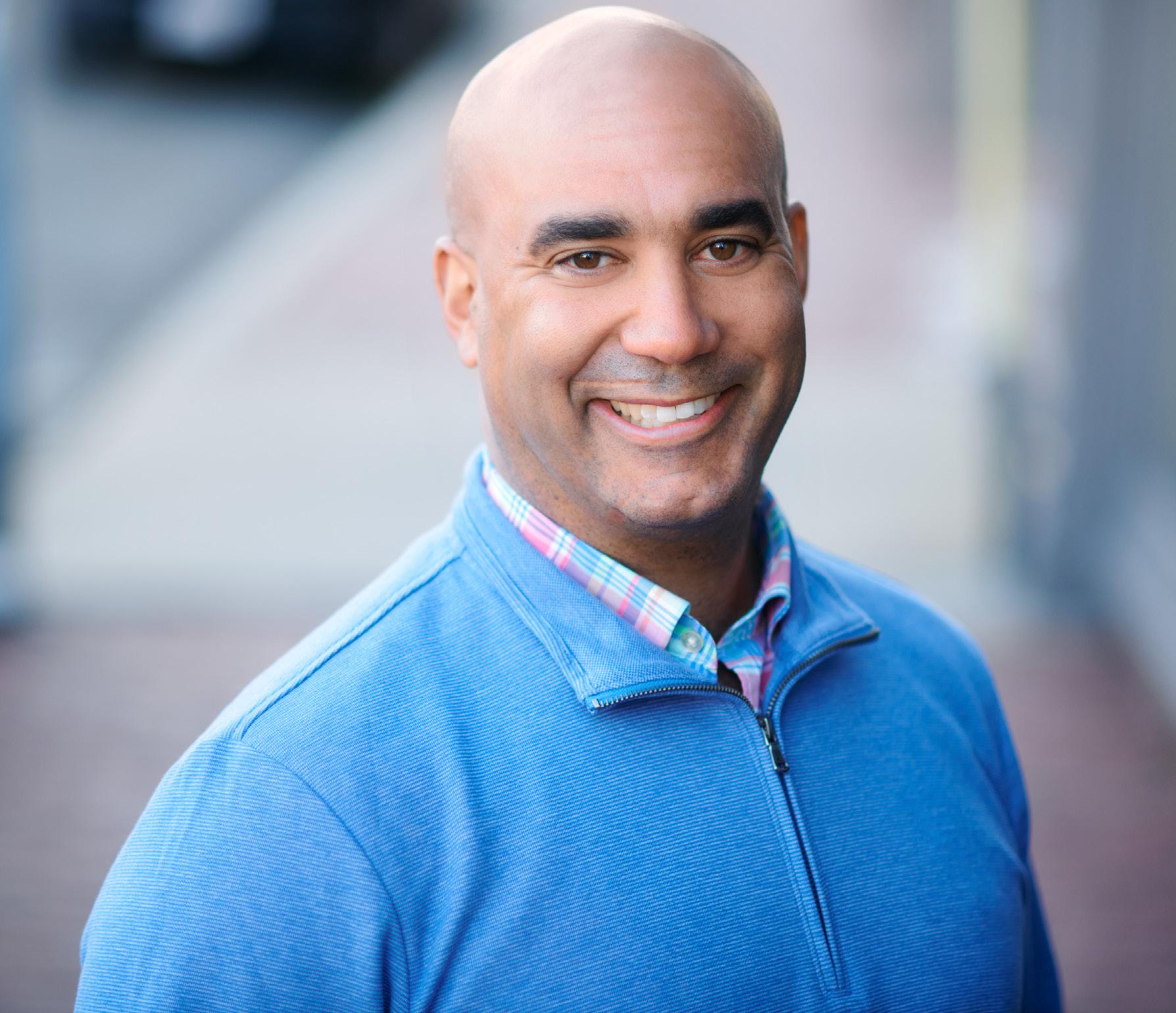
“When you are a leader, there are times when you get identi ed individually, and that feels good,” he said. “But more importantly, I think as a leader, you need to recognize that you never, again, you’re never working in isolation. It’s a team goal.”
Team collaboration and the passion of teenagers is what leaves Turner motivated at the end of the day.
“I just was recently—yesterday—with a group of teachers who are working [on] their instruction and grading and whatnot, and I just was really inspired by their collaboration [and] their re ection on their work,” he said. “And I think when you work with kids, it just inherently makes you an optimist.”
Turner said he is proud of how students at Newton North regularly confront di cult subjects. Whether inPHOTO COURTESY OF HENRY TURNER
 BY CAITLIN CLARY Heights Staff
BY CAITLIN CLARY Heights Staff
DoorDash awarded Corner Café Newton $20,000 as part of the delivery service’s Main Street Strong program, created to support small businesses impacted by the COVID-19 pandemic.
e Corner Café Newton has really struggled during the pandemic,” said Chris igpen, the café’s owner. “So what the grant means for us, basically, it helps us play catch-up.”
DoorDash’s program awards 100 restaurants located in ve U.S. cities $20,000 grants and a curriculum program for owners to develop new skills, according to a post on its website.
e Corner Café Newton, located at 321 Washington Street, has been serving Newton residents breakfast and lunch for over 55 years.
igpen has owned the café since 2019. As a new business owner, he said he has faced many challenges during the pandemic.
e business owner said he had to adapt after customers who visited the café on their lunch breaks started
working from home in March 2020.
“We sit in a little o ce district,” igpen said. “When the pandemic hit, nobody came to the o ce, which was pretty terrifying for a new business owner.”
igpen said he took advantage of delivery services during the COVID-19 pandemic. e services, he said, help new customers find out about the business.
“ e cool thing about … this little
tops o the tasty dish.
Da LaPosta is just a 20 minute walk from Boston College’s Newton Campus.
One Needham resident, who said he plans to return to the restaurant, had the cavatelli and housemade sausage pasta.
“[It had] a nice fennel taste to it—a little spice,” the customer said. “ e pasta was nice and pillowy.”
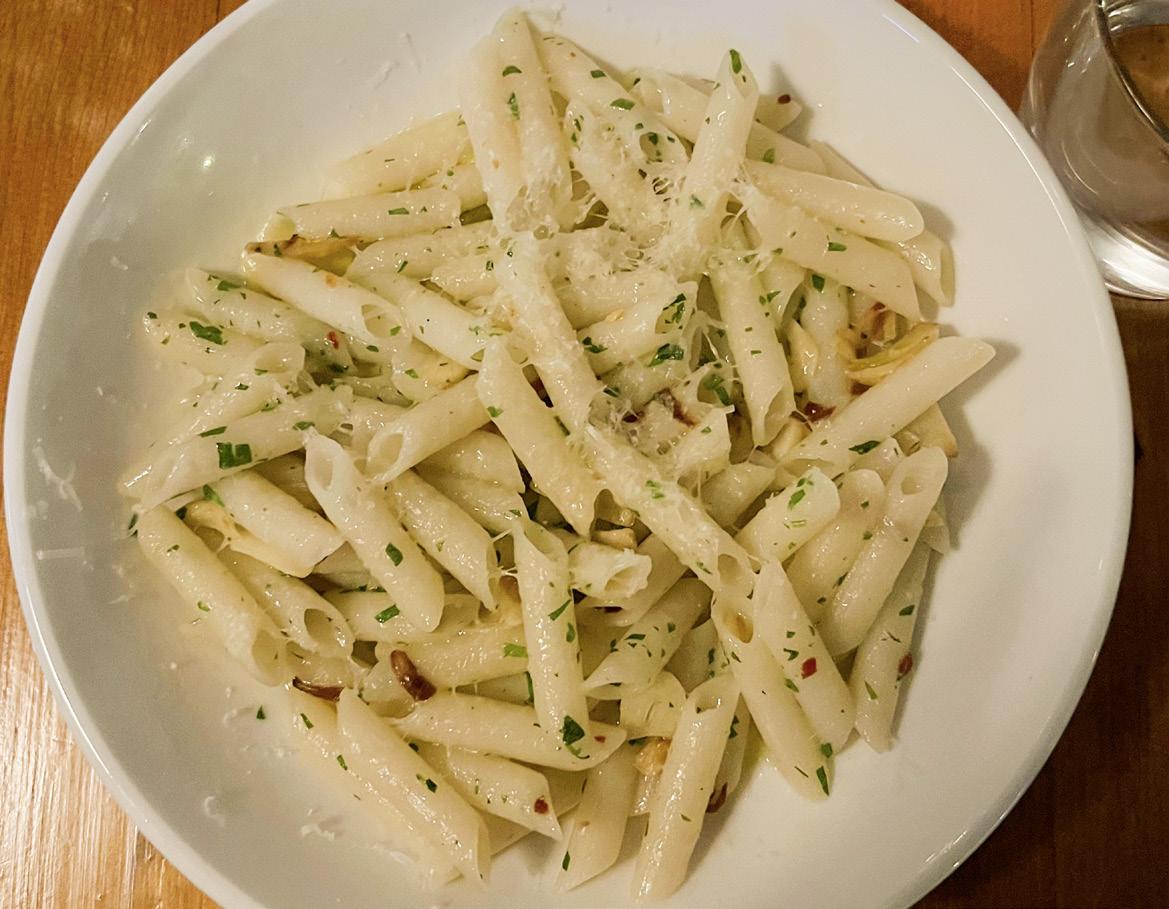
e restaurant lets customers split the dishes for more to enjoy.
business is that [the pandemic] has forced us to go out and get new clients,” he said.
When igpen rst heard about DoorDash’s grant program, he took action.
“I work with DoorDash and UberEATS and Grubhub now, and [the Main Street Strong program application] came across the wire,” igpen said. “You create a pro le, and then you answer a bunch of questions about … the e ects of COVID on your business.”
With fewer in-person customers, igpen said he has adjusted his business strategies in addition to utilizing delivery apps.
“Because foot traffic has been so low, I’ve really tried to get more catering orders—breakfast and lunch catering, sort of corporate delivery stu ,” igpen said.
Despite the challenges of the pandemic, igpen said he remains condent in Corner Café Newton. He said the Main Street Strong program has been a source of energy and optimism.
“Having that kind of as a bu er is amazing because it allows you to not be terri ed and to … put one foot in front of the other, keep showing up, doing the thing, knowing that it will get better,” Thigpen said. “And I’m con dent it will get better.”
BY FIONA FLANAGAN Heights StaffDa LaPosta Pizzeria opened in November in Newton, and its liveliness and charm might be enough to rival the renowned restaurants of Boston’s North End.
“You can have fun with friends, and hang out and have apps and a few drinks, or you can come with the family if you want to be a little more formal,” Sarah Chag, a Needham resident and diner at the pizzeria, said.
e experience at the restaurant is engaging and ful lling. e dim lighting and youthful music lure customers through the door, the personable sta makes them want to stay, and the delectable food inspires them to book their next reservation.
e warm interior of Da LaPosta, located at 825 Washington St., is inviting. Large tables can seat whole families, while dim lighting and tables for two make for a great date night. e long wood bar is perfect for friends looking to have a few drinks or watch a game.
Mario LaPosta, the owner of the restaurant, said Da LaPosta has been a project in the making over the past few years. He said he wants the space to be a staple for residents nearby.
“I hope Da LaPosta brings, number one, great pizza, [and] a great restau-
rant that the Newton community can feel like is a part of the neighborhood,” LaPosta said.
With his previous experience working in the Seaport District, LaPosta crafted a menu authentic to his Italian name. From bread and clams to pizza and pasta—including the gluten free kind— Da LaPosta has something for everyone.

e spaghetti aglio e olio—pasta with garlic, chili, parsley, and olive oil—is a refreshing twist on a classic dish. Chili akes add a spark of spice to tender pasta.
e garlic and parsley add maturity to the avor pro le. Grated parmesan cheese
“We did a lot of appetizers. I couldn’t even have a full meal,” Chag said. “We had the focaccia with the cheese in it, which is amazing because it’s cheese and it’s bread. I had the suppli, which is like an arancini, and we had the calamari, [and housemade] ricotta.
Customers can view the restaurant’s hours and make reservations through Da LaPosta’s website.
“If there’s something on the menu that they [want but we don’t have], they can still ask,” LaPosta said. “If there’s something we don’t have as a cocktail or wine, they can still ask. [Da LaPosta] is something that’s just really suited for the locals [who] want to be at a place where they feel like they can get what they want.”
Brookline Police charged an 18-year-old with arson on Wednesday following a fire that ripped through a vacant home adjacent to Pine Manor College in Brookline, according to a Brookline Police Department Facebook post.
Two Boston College Police officers spotted and reported the fire at 2:35 a.m. on Jan. 25 at 89 Woodland Rd., the post reads.
The road borders Pine Manor College, which Boston College absorbed in May 2020 and now serves as the University’s COVID-19 isolation housing.
The Brookline Fire Department quickly put out the fire and determined the house was vacant, but not before one firefighter sustained minor injuries, according to the post.
Before spotting the fire, the BCPD officers noticed someone in the area and provided Brookline officials with a description.
According to the post, one Brookline officer traced footprints
in the snow to a home on Shaw Road.
Police obtained a search warrant for the home, and further investigation led to the arrest just over a week later.
The 18-year-old, whose name has yet to be released, was charged with willfully and maliciously setting fire to a house and injuring a firefighter as a result of a criminal offense, according to the post.
The Brookline District Court arraigned the suspect on Wednesday.
The house last sold in 2018 for $1.8 million, according to Brookline’s assessors database.
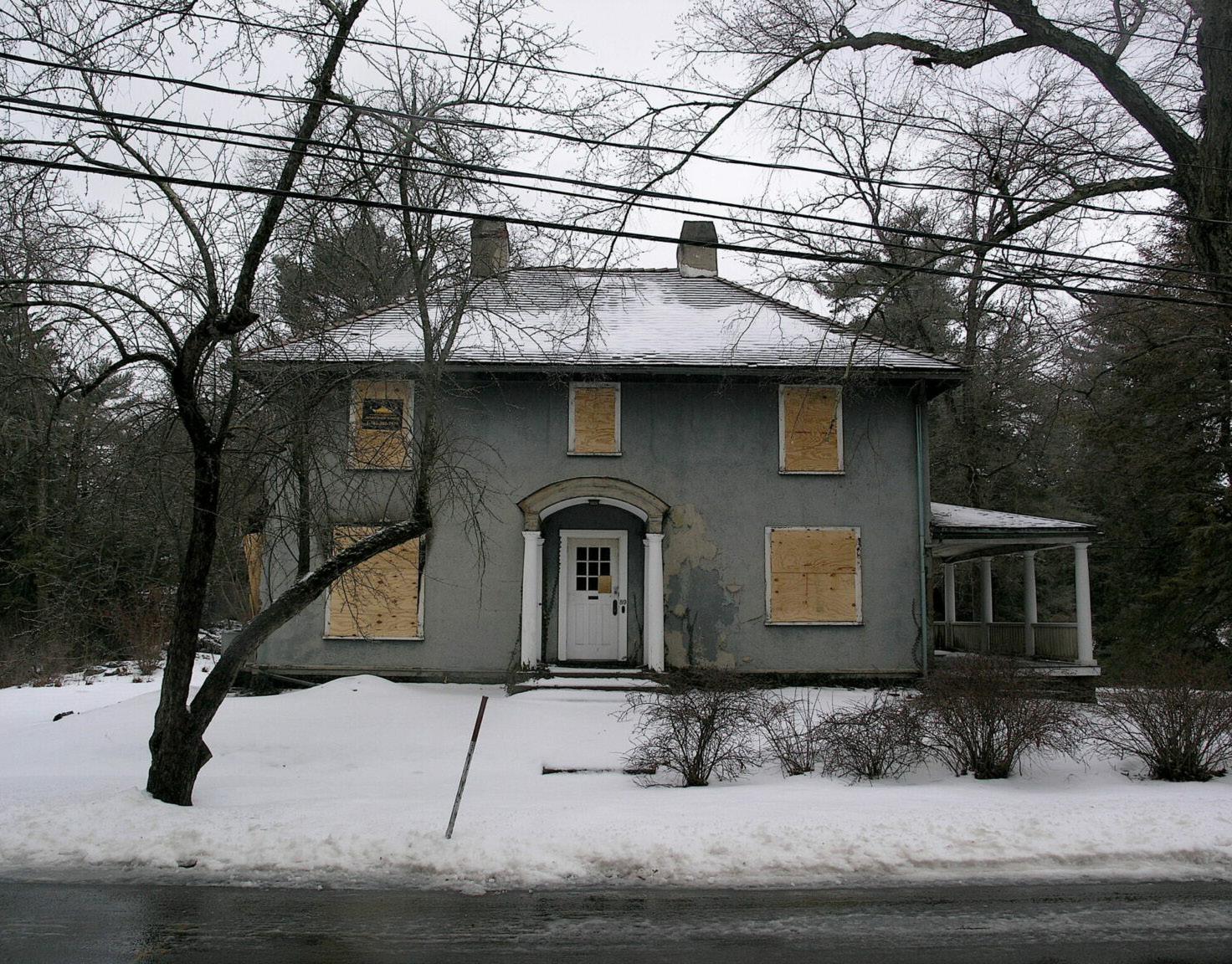
On Friday, the windows of the home were boarded up, and a smokey scent lingered around the property.
“At this time we would like to thank the Boston College Police Department as well as the Brookline Fire Department and the members of the Massachusetts State Police assigned to the Fire & Explosion Investigation Section of the Office of State Fire Marshall,” the post reads.
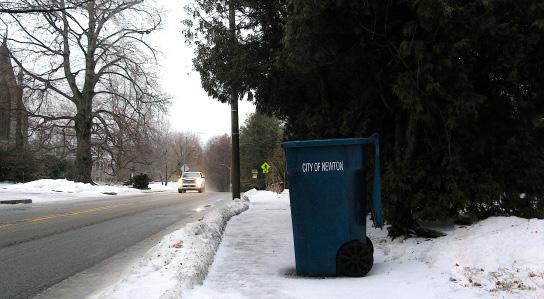 BY CONNOR SIEMIEN Asst. Metro Editor
BY CONNOR SIEMIEN Asst. Metro Editor
e winter storm on Jan. 28 and 29 brought 18.1 inches of snowfall and set in motion a familiar yet difcult process for Newton’s Department of Public Works’ (DPW) Streets Division: snow removal.
Shane Mark, director of the Streets Division, outlined the division’s procedures to ensure safe travel in the days following a snowstorm.
In the days leading up to the storm, the Streets Division soaked the roads with a mixture of salt brine and beet juice, which helped to delay snow and ice from freezing on the roads, Mark said.
Due to the heightened demand for snow-related services, Newton usually relies on its own snow-clearing equipment and workers when facing a storm this large, according to Mark.
“It’s tough to get additional pieces in events like this because contractors and people that do snow and ice removal and plowing are already committed to other communities,” he said.
Nevertheless, Mark said that the DPW was well equipped. According to Newton Mayor Ruthanne Fuller’s update on Jan. 29, the city deployed 186 pieces of equipment during the peak hours of the blizzard.
e Streets Division cleaned up the streets for cars to drive safely, but there remains room for improvement, Mark said.
One of the main issues is the buildup of snowbanks and piles along the roadside, according to Mark.
e lack of places to store snow in Newton, and the amount of snowfall, exacerbated the problem.
Newton resident Ollie Coughlin said that she saw some improvements with the cleanup of this storm compared to previous years.
“I noticed that a walkway, … typically it’s not shoveled by the city, but this time it was,” she said.
Mark acknowledged that the large snowbanks are an inevitable challenge when the snow total climbs over a foot, and he said it is an issue without an easy solution.
“We don’t have places to store all the snow, so it’s just an inevitable part of plowing,” Mark said. “[ e key] is really just mitigating those piles and hauling those piles away to prevent line-of-sight issues and accidents after the storm.”
Newton enforced snow-related sidewalk ordinances for both business owners and homeowners. Coughlin said she and others received emails from the city reiterating the ordinances before the storm.
According to Newton’s winter weather brochure for 2021 and 2022, DPW is responsible for removing snow from streets and sidewalks surrounding city-owned land. Property owners are responsible for clearing their own sideways and ramps. Failing to comply will result in warnings and possible nes, according to the
brochure.
Residential property owners must maintain a non-slippery, walkable area free of snow and ice in the 24 hours after the storm, according to Newton’s ordinances. For commercial buildings, institutional buildings, residential properties with more than four dwelling units, and buildings within business districts, the timeframe is 12 hours.
Potential consequences for untreated sidewalks consist of a written warning from the city for residential properties on the rst o ense during the snow season—which spans from Oct. 1 to April 15—and $50 for each subsequent o ense during that time
period.
For businesses, the rst o ense is a $100 ne, going up to $300 for the third o ense and each subsequent o ense afterward.
Mark said the DPW investigates city sidewalks and some residential properties, while the Newton Police Department seeks out businesses that do not comply with the ordinance.
According to Mark, the city began enforcing these rules more strictly over the last few years.
“ e nes are starting to work, especially in the second year [of stricter enforcement]—and it’s all about communication,” Mark said.
He noted that various neighbor-
hood groups sent out emails about the nes.
Mark said he suggests that Newton residents remain patient when facing future storms—especially when it comes to allowing snow-removal crews the time and space to clear the roads.
“During these snowstorms, do not venture out if you do not need to go outside,” Mark said. “Don’t crowd the plows, and try to be patient at the end of the storm. ese large storms create lots of issues, … so it takes us days and days to clean up. We’re working through addressing those issues, and we appreciate everyone’s patience and understanding.”
U.S. Representative Jake Auchincloss and Newton Mayor Ruthanne Fuller took a test ride together on Monday using NewMo, an app providing on-demand public transit in the City of Newton. NewMo, short for Newton in Motion, makes transportation exible, Fuller said.

“God bless the MBTA and the bus routes, but they’re xed routes, and we don’t live our lives in xed patterns,” Fuller said. “Typically when you get outside of really tense areas like Boston, there are so many Newtons in the Commonwealth.”
Fuller launched NewMo in 2019, originally intended as a door-to-door
service for seniors throughout the City of Newton. Last October, the service expanded, allowing users to ride anywhere in the city.
Both Fuller and Auchincloss took NewMo from Newton Centre to the Newton Housing Authority, where they spoke to the public about the service.
Auchincloss described NewMo as innovative.
“Newton has really been a pioneer of on-demand microtransit within Massachusetts,” Auchincloss said.
Auchincloss said microtransit services like NewMo are intended to ll “transit deserts,” or gaps between homes and transportation centers such as bus stops and train stations.
“It’s really about complementing public transit and walking and biking,”
Auchincloss said. “You need all of these di erent modalities working together to connect people to jobs and services and to make it more convenient and less costly.”
Via, a transportation software company, built the app. Auchincloss said the company created the app in a way that meets the community’s need.
“Unlike some of these other companies that have emerged in the last 10 years, [Via] worked with the city to say, ‘Hey, where are your challenge areas and how can we help?’” Auchincloss said.
Two-thirds of the app’s user base, since its expansion, are commuters, and one third are seniors, according to Nicole Freedman, director of transportation planning in Newton.
For seniors, the service is meant
to be a door-to-door service, whereas for commuters, it’s a corner-to-corner service.
NewMo also allows senior residents to get to medical appointments outside of Newton, Freedman said.
“Fifty percent of our seniors are taking these trips to medical appointments,” Freedman said. “ ese get scheduled weeks—if not months—ahead, so they can pre-book, so they are guaranteed to get there.”
Recently, seniors have also been using the service to get to COVID-19 vaccination and testing appointments, according to Jayne Colino, director of the Newton Department of Senior Services.
“We actually had a great relationship with a private medical group that did vaccines,” Colino said. “It was a lifesaver—both the vaccine itself [and] the transportation to get to it. You can imagine trying to get to some of the bigger mass vax sites intimidate people, so this was a perfect storm.”
To make the app more accessible, Colino said NewMo volunteers are trained to help people use the app, and seniors can be matched with people who are comfortable riding in NewMo when using the service.
“We were very deliberate in creating this program to have access both by phone and the app,” Colino said. “It’s not just an age issue—it’s an economic issue as well. Both the library and the senior center now loan out phones as well, so lots of ways to have access to technology to do this.”
According to Amy Zarechian, the executive director of the Newton Housing Authority, clients of her organization
have been taking advantage of the service as well.
Some quali ed low-income Newton residents can pay $0.50 per ride, while others pay $2 per ride.
“We’re really grateful that our residents can utilize this service … at a reduced rate,” Zarechian said. “A lot of our residents want to go to other places—for example, to doctors, friends, and social networks. So it’s been great.”
Freedman spoke about the importance of NewMo receiving funds from multiple sources, including regional and national grants.
“I always believe in diversi ed funding,” said Freedman. “We’ve been doing grant funding for operations. And, you know, it’s still a pilot as a microtransit.”
Congress proposed a bipartisan infrastructure bill that would provide funding for microtransit services such as NewMo.
“We worked hard in the bipartisan infrastructure deal to get at least five programs for which on-demand or microtransit would be eligible,” Auchincloss said. “And now, our goal is to really advocate to [United States Secretary of Transportation Pete] Buttigieg and other administration o cials that these programs are critical and complimentary to xed rail and bus public transit.”
Freedman said she expects the service to continue to grow in the future.
“I mean, we’re still growing,” Freedman said. “We grew 10 percent again since the holidays, and the seventh vehicle is now nearing capacity—I would bet in two to three years [we’ll have] 13 to 15 vehicles.”
I, like many college-aged women, have not purchased a bottle of dairy milk in my entire adult life. My cups of co ee are topped o solely with almond milk, oat milk, or on the rare occasion, soy milk.
But, I have one exception to this rule: my raspberry scones. e only time I have purposefully bought a bottle of whole milk in the better part of a decade is to make this recipe. After making these scones, I’m left with about half a bottle of whole milk that will sit in my fridge until I rediscover it after a month or so and decide it’s nally time to throw it away.
Nevertheless, these scones make breaking my non-dairy streak so
worth it.
DISH: Raspberry Swirl Scones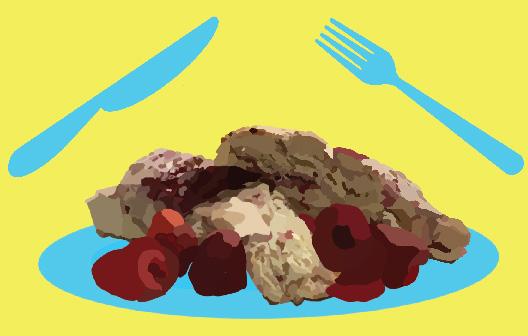
INGREDIENTS:
3 cups our ⅓ cup sugar
1 tablespoon baking powder
1 pinch of salt
12 tablespoons cold, unsalted butter cut into cubes (about 1½ sticks)
¾ cup whole milk, with a few extra tablespoons to brush on top for baking
1 6-ounce package of raspberries (fresh or frozen)
RECIPE:
Preheat the oven to 375 degrees Fahrenheit. Grease a baking sheet and set it aside.
Add the our, sugar, baking powder, and salt to a large mixing bowl. Whisk until well combined.
Cube the butter, and add it to the dry ingredients. Use your hands— this is the best part—to combine the butter with the dry ingredients until it makes a sandy mixture with butter pieces not much bigger than the size of a large pea.
Drizzle the milk over the mixture, and stir with a spatula until mostly combined.
Fold in the berries with your hands. Don’t be afraid to break up the berries—doing so will give your scones a beautiful pink swirl. Knead the dough with your hands until all the our is combined, and form the dough into a large ball.
Transfer the dough onto a lightly oured surface. Shape the dough
BY OLIVIA JOUNG Copy EditorDespite progress in recent years regarding women’s rights and gender equality, the issue of sexual violence and trauma against women remains a taboo subject.
M. Brinton Lykes, co-director of Boston College’s Center for Human Rights and International Justice and professor in the Lynch School of Education and Human Development, and Alison Crosby, associate professor at York University’s School of Gender, Sexuality, and Women’s Studies, have been exploring the topic for years, which has culminated in their recently published book, Beyond Repair?: Mayan Women’s
Protagonism in the Aftermath of Genocidal Harm.

In the book, Lykes and Crosby discuss how Mayan women have sought, and continue to seek, justice for the harm they su ered at the hands of the Guatemalan state during the early 1980s at the height of the 36-year Guatemalan Civil War, drawing primarily from eight years of research.

Lykes said she initially became interested in gender issues and human rights by getting involved in anti-racism work in high school.
Her fascination with the subject further blossomed during her undergraduate studies at Hollins University, where she received her bachelor’s degree in philosophy and religion in 1970, she
said.
Lykes then attended the Harvard Divinity School, where she learned more about liberation theology, a set of Latin American ideologies concerning social class contradictions and impoverishment.
She received her master’s in divinity degree in 1973.
From there, Lykes began focusing on gender issues, speci cally violence against women, which was especially prevalent at the time among African American women in the Greater Boston area, she said.
“I bumped into feminism, or gender issues, because in divinity school in those days, there were very few women,” Lykes said. “And the men looked at the women as if we were there to meet husbands, which had never occurred to me.”
While in divinity school, she traveled to Nicaragua, where she met some men and women who had ed the massacres in the highlands of Guatemala during the early 1980s.

is would eventually spark her interest in the Guatemalan Civil War and the atrocities Mayan women faced as a result.
“What they talked about, and how they expressed themselves about who they were, converged with some long-standing interest I had in psychology and the assumptions of individualism,” Lykes said. “ at was the beginning of what turned into almost 30 years of living in Guatemala … in the midst of their 36-year armed con ict.”
Crosby, on the other hand, became interested in human rights as a student at the University of Cambridge. She spent a summer in Montreal, Canada working for a community center that worked with mostly Latin American refugees and communities in exile. After graduating, Crosby continued to work with these communities—primarily Guatemalan and Salvadoran communities in exile in Mexico and El Salvador for several years.
“ at sort of sparked my long-term interest in women’s movements and organizing within these very deep-seated, con ictual situations,” Crosby said. “[ at] led to me doing research with Guatemalan refugee women’s organiza-
into a at disk about 1½ inches thick. Cut the dough into wedges. Transfer the cut scones to the prepared baking sheet, leaving ample space between them to keep
them from touching as they bake. Lightly brush the scones with milk, and sprinkle sugar on top. Bake for 20–30 minutes or until the scones are lightly golden.
tions as they were organizing to return to Guatemala, and this question of ‘How do you go back home when home is changed and you have changed?’”
Crosby said several women’s organizations in Guatemala, Peru, and Colombia were beginning to work with women who had survived sexual violence during armed con icts.
As a result, she began to aim at helping Mayan women share their stories about what they had experienced in Guatemala while working for Inter Pares, a Canadian social justice organization.
“In the Guatemalan context, for example, there had been a truth commission process after deciding the peace accords,” Crosby said. “But the issue of gendered violence and sexual violence wasn’t highlighted as much as it could, perhaps, have been.”
After both having individually worked in Guatemala—Lykes through Equipo de Estudios Comunitarios y Acción Psicosocial (ECAP), and Crosby through Unión Nacional de Mujeres Guatemaltecas (UNAMG)—the two eventually met through a mutual friend. Later, Crosby invited Lykes to help facilitate a regional workshop for mental health promoters in 2000.
From there, they decided to pursue research with 54 Mayan women seeking redress and reparations for the violence they had su ered during the war, who were participants of a previous UNAMG project. is research would eventually culminate in Beyond Repair?, Lykes said.
In the eight years that they spent researching in Guatemala with UNAMG ,in collaboration with ECAP and Mujeres Transformando el Mundo (or Women Transforming the World), another non-governmental organization, Lykes and Crosby utilized Participatory Action Research (PAR).
PAR is an approach to conducting research that involves researchers and participants working closely together in an e ort to understand and solve whatever issue they are addressing.
ey both found it important to partner with the Mayan women, rather than merely treating them and their suffering as regular research subjects, Lykes said.
“Sometimes, those of us who are educated in universities think of ourselves as the knowledge creators and don’t recognize with su cient humility ... a sense of the limitations of our own knowledge systems,” Lykes said. “So we were very committed to trying to ... not do work that took the place of others’ work, but rather partner with people that were already on the ground working.”
Lykes had previous experience with PAR in Guatemala prior to her research with Crosby, during which she and her co-workers helped women share their pain through theatre, drawing, and other participatory forms of visual and dramatic art.
Folding the raspberries into the dough with your hands produces a pink swirl. Read the rest of this story at www.bcheights.com
Parr is an Irish photographer who is renowned in the arts community for his innovative portraits and insightful photographs with themes of changing political and social landscapes, focusing on Ireland. While Parr has displayed his work in the U.S. before, this is the rst exhibit to display such a wide variety of his body of work in one exhibition.
“We nd it surprising … that Parr really isn’t very well known here, whereas in the United Kingdom, where he’s from, he is like a superstar documentary photographer,” Kate Shugert, manager of publications and exhibitions at the McMullen, said. “So we were very lucky and very honored to be able to host his rst big museum exhibition in America.”
Karl Baden, curator of the new exhibit and associate professor of the practice of studio art, said he has admired Parr’s work for a long time.
Chris Killip, a photographer and Baden’s friend, mentioned that his friend Parr wanted a place in the U.S. to display his work. Baden dedicated the exhibit to
Killip, who died in 2020.
Baden submitted a proposal for the exhibit at the McMullen in 2019 and collaborated with the Irish studies, art and art history, and English departments for approximately two years to piece the exhibit together.
Time and Place begins on the third oor of the McMullen with Parr’s “Autoportraits,” photographs that Parr paid to be taken of himself in souvenir shops for tourists around the world. Fascinated by these portrait studios, Parr would go into the studios and commission photographs of himself in front of outlandish backgrounds, including pyramids or ying planes, while staring deadpan into the camera, Baden said.
“Autoportraits” appears to satirize the typical family tourist photo, as do his photos in his Small World series on the second oor of the museum.
In one photo of the Small World series, “Leaning Tower of Pisa, Italy,” Parr photographed people pantomiming holding up the famous building–a quintessential tourist pose. But instead of taking the photo so the tourists appear to actually be supporting the tower,
Parr angled himself so the viewer could see the absurdity of this pose. e image addresses the impact of global tourism on landmark tourist destinations, Baden said.
e rest of the exhibit showcases photos from other series—including “ e Last Resort” and “ e Cost of Living”— which contemplate and satirize British society. Other featured photographs are from Parr’s expansive collection of images of Ireland between 1979 and 2019.
Parr’s photos of Ireland address themes of social class and consumption, curiosity and humor, as well as humanity and its predictability, according to the plaques in the exhibit.
In their collaboration for the exhibit, faculty from the Irish studies department—Marjorie Howes, Vera Kreilkamp, Joseph Nugent, Robert Savage, James Smith, and Guy Beiner—categorized the photographs in a way that demonstrates the country’s transition from being an isolated society to its modernization, Baden said.

Parr begins his photography of Ireland in black and white and moves to color. is progression correlates with the
modernization and rise of consumerism in Ireland through the years, Baden said.
In his earlier black-and-white photographs, Parr captures Ireland’s aged views of gender roles with “Rosses Point, County Sligo,” in which the sea swimming spot photographed was segregated by gender. Moving through the years of Parr’s photographs, women gradually appear more in the images, demonstrat-
ing social changes as Ireland became modernized.
e breadth of Parr’s work displayed in the exhibit makes it a must-see for everyone, according to Baden and Shugert, “We want people to see the photographs and want to learn more about Parr and be excited about his work and excited about photography exhibitions in general,” Shugert said.
Frigid temperatures and freezing rain did little to dampen the spirits of the people gathering in Robsham eater on Friday night. e sense of excitement was palpable as conversation buzzed around the auditorium. e crowd eagerly awaited the opening night of Dance Organization of Boston College’s (DOBC) two-night annual showcase, titled Electric
In a message written in the event’s program, Regan Hayes, director of DOBC and CSOM ’22, described the group’s inspiration for the show.
“[It is] re ecting on our collective experience as a team over the past several years,” Hayes said. “Despite so many challenges, we have been powerful and resilient, brought together by our love of movement and positive energy.”
e audience echoed the dancers’
positive energy as the lights went down and cheers swelled from the crowd to support the performers.
e rst number of the night was a lyrical piece to Lucy Dacus’ cover of “La Vie En Rose.” Before each dance, a video was shown on stage of the choreographers giving a summary of why they chose each song.
Choreographers Suzanne Quigg, MCAS ’22, and Angela Liu, CSOM ’22, said that they emphasized the song’s themes of nding true love by including uid movements that expressed longing and hope for the future.
At times, most stage lights went down, leaving just the dancers’ silhouetted gures visible as they ew across the stage in perfect unison.
In the introduction videos, many dancers also took the opportunity to express thanks to their friends and family for all of their support. Quigg and Liu explained in their video why they chose “La Vie En Rose”—which translates to “life in pink.”
“DOBC has brought us to see our BC experience through rose-colored glasses, ‘’ Liu said.
roughout the rest of the rst act, DOBC alternated between slower dances that awed the audience with expressionism and dances to more animated pop beats.
e energy in the room grew when the opening notes of the Glee cast’s recording of a “Survivor / I Will Survive” medley played. e catchy tune had the audience clapping along from the beginning. e dancers stoked this energy with a dynamic, pop-style routine as they commanded the stage.
Synergy Hip Hop Dance Company made a guest appearance by playing a video of its spring 2021 set called “SYNPARTY.” Dancing in the video to a variety of hip hop beats including “Good Form” by Nicki Minaj, the group’s set came alive with the precise execution of hip hop moves.
Synergy returned on video once more in the second act with a short-
er virtual performance. Still as alive as ever with the pulsing movements of hip hop dance, the set started on a slower note with a dance to “Make It Out Alive” by NAO. e camera dramatically circled around the group as Synergy gave a rousing nish.
DOBC closed out its show with two special numbers. e group’s seniors performed to the song “Survive” by Madilyn Bailey as they cel-
ebrated their last annual showcase. e last routine, titled “Electric,” was a medley of tunes choreographed by the group’s o cers and featured dancers of every class year.
As the performers took their nal bows, the crowd rose to its feet. Energy coursed throughout Robsham one nal time as DOBC ful lled its promise to deliver an electric evening.
 BY ERIN PENDER Heights Staff
BY ERIN PENDER Heights Staff
The Heights Room was transformed into an underwater world, with small fish and blue streamers dotting the walls, for the Campus School’s eighth annual Arts Showcase on Thursday. The event, called “Under the Sea,” was full of energet-
ic performances.
Alexa Norton, Lynch ’23, a member of the Campus School’s arts committee, introduced the event as a fundraiser for the Campus School, including performances from arts groups on campus.
Located on Boston College’s campus, the school serves students between the ages of three and 21, who are in need of a highly specialized
education.
The first to perform were the Heightsmen, BC’s all-male a cappella group, singing “Runaround Sue” by Dion DiMucci and “Fly Me to the Moon” by Frank Sinatra. Their smooth harmonies and charming presentation engaged the audience.

Next, three dancing pairs from Full Swing each performed a dance. The dancers impressed the crowd with their acrobatic skills and flexibility, as well as the chemistry between pairs.
The Acoustics, another a cappella group, sang “Yoü and I” by Lady Gaga. Francesca Giangiulio, MCAS ’23, performed a solo and navigated the riffs and high notes of the song, creating an energy that the rest of the group matched.
Between each group, volunteers from the Campus School explained how they joined the organization, with many emphasizing their own personal connections to schools that provide special education. The introductions reminded the audience of the students who the performance
was benefitting and of the significance of the crowd’s support for the school’s programs.
Next, the Sharps, BC’s all-female a cappella group, sang “Liability” by Lorde. Their hauntingly beautiful arrangement inspired deep emotion in the audience.
A video following the Sharps’ performance featured a boy named Jack at the Campus School and explored a day in the life of a student.
His mother emphasized the importance of those at the school seeing Jack as something more than his diagnoses. She said that by engaging with the Campus School, he and his family feel like part of the BC community.
Following a brief intermission, BC Dance Ensemble performed to “Poker Face” by Lady Gaga. The group of six women demonstrated flexibility and various styles of dance.
In the next introduction, another BC student emphasized that she joined the Campus School because she wanted to be a part of a community that believed in inclusion.
The Common Tones of BC emphasized a similar sentiment as an a cappella group that also does community service. The group performed “Forever On Your Side,” by NEEDTOBREATHE, a song with a message of inclusion and community. The group also sang “prom dress” by mxmtoon.
To close out the show, BC Irish Dance performed “Paradise” by MEDUZA with Dermot Kennedy. Their fast-paced footwork and skillful choreography proved a lively finale for the evening.
After pulling raffle tickets and awarding audience members gift cards to local eateries, Sara Hernando, co-president of Campus School volunteers and MCAS ’22, announced that the Campus School had raised over $1,000 to further its mission.
“Under the Sea” marked a successful return to in-person arts events for the Campus School and allowed BC students and faculty to come together to support other community members.
bate regarding how to honor Black history involves educating Americans on unsettling historical truths.
As February marks the annual celebration of Black History Month, much of the social and political de -
The documentary Who We Are: A Chronicle of Racism in America presents facts about the ubiquity
of slavery in the U.S. and explains how white supremacy has always had a central role in the country’s affluence.
Part lecture and part investigative documentary, the film follows lawyer Jeffery Robinson as he visits monuments and speaks with families who have been severely impacted by racial violence.
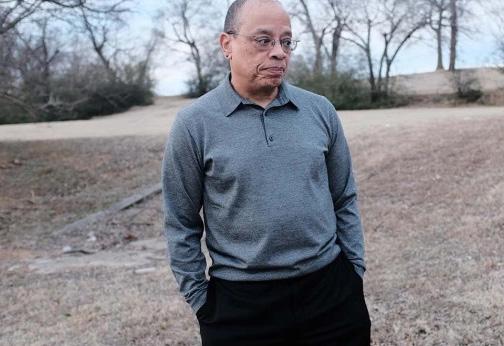
Segments of a lecture that Robinson gave on Juneteenth in 2018 show Robinson as contemplative, earnest, and fascinating.
He educates audiences on moments in history where prejudice against Black people was overlooked, admitting that much of the history is unfamiliar to him.
The film prompts audience members to confront deeper questions regarding how racism is inherent to this country and the prosperity of its
more privileged citizens.
In one segment, Robinson visits a former site for slave auctions in Charleston, S.C., learning that the building used for the auctions was built by slave labor.

It serves as a stark reminder that cities across the U.S. were built using slave labor, and almost all of the pushback against the freedom of slaves lay in the need to preserve cheap labor to keep profits high.
Now considered the wealthiest country in the world, the U.S. began this trajectory by profiting off the ownership of other people.
More of an educational piece than an artistic film, Who We Are is still engaging and well organized, as Robinson’s lecture serves as an effective framework with which he can easily move from one historical event to another.
Presenting more realistic and jarring answers about the history of racism and events of prejudice that are regularly overlooked in the country, the documentary is essential viewing for Americans who have been denied proper teachings on Black history.
Robinson makes it clear that there are many more examples of injustices to Black men and women that are not widely recognized by the broader population. But, the creators of the film could not fit everything into its two-hour runtime.
The documentary emphasizes how there is still more to learn regarding the centuries of prejudice Americans caused or were complicit in. A crucial watch, Who We Are and Robinson’s teachings offer a reliable way to engage with and learn more about Black history.
The words on the page slowly embed the story in your brain. Its meaning moves through your veins, as if passed down from previous generations. But you don’t realize how tightly the story has wound itself around your heart until it’s too late, and you nd yourself heartbroken.
That’s what it feels like to read Isabel Allende’s new novel Violeta e acclaimed author’s recent release is seemingly boundless, as it spans 100 years of the life of protagonist Violeta through a multitude of historical events—including pandemics, World War II, and the Cuban Revolution.

Beginning with financial and familial upheaval, Violeta’s life tells the story of a woman picking up the remains of a broken family and nurturing a newfound one unconstrained by blood relations.
Throughout the novel, Violeta
navigates passionate and dangerous relationships, motherhood, and tragic loss. Allende leaves the reader reeling in the tracks of this fast-paced account of a distinctive life.
The novel plays with a balance between isolation and freedom in the characters’ homes and families, the political and historical context, and Violeta’s romantic relationships.
e rst chapter, set after Violeta’s birth in 1920 during the Spanish flu outbreak, chronicles scenes of people wearing cloth masks in public and political leaders giving orders to stay at home.

History seems to repeat itself, as the words on the page trigger memories of masked grocery store trips and governors’ news broadcasts during the COVID-19 pandemic.
In the rst pages, Allende introduces the format of the novel as Violeta’s memoir, which she is writing to a person named Camilo. The author withholds Violeta’s relation to Camilo until the





nal section of the novel, delivering an emotional blow to a reader who has witnessed the heart-rending path of Violeta’s life.
At times, the rhythm of the storyline falters when Violeta suddenly addresses Camilo. But, for most of the approximately 300-page book, Violeta’s narrative voice recounts tragic details framed by the wisdom of an old woman re ecting on her life.
As a 66-year-old woman, Violeta nds herself immersed in an exhilarating new love, as she moves past the pain of her past relationships. Allende’s tale centers around a woman whose life continues to expand and become richer as Violeta ages, contradicting the cultural trope that women should fear aging and the changes that accompany it.
From a mother’s di cult birth, to a mentor ghting for women’s su rage, to Violeta’s escape from her abusive partner, a cast of resilient female characters is at the heart of the novel. Female characters fight for survival in every phase of
Violeta’s life, while male characters are driven into the ground by their own shame or hubris.
Beneath the tales of tragedy is a story of hope and new beginnings. In a letter
to Camilo, Violeta strives to package up her life story.
Read the rest of this story at www.bcheights.com
 BY KIERAN WILSON Heights Staff
BY KIERAN WILSON Heights Staff
Considering he’s still in college, Hans Williams is wise beyond his years, and it shines through in his music. He has cultivated a unique alt-pop sound driven by acoustic guitars, warm and e ortless melodies, and a knack for relatable and personal storytelling. If you are looking for an honest and raw singer-songwriter with pop tendencies, Williams is the artist for you.
Even with only seven songs on his
Spotify page, he has upward of 96,000 monthly listeners. His most popular song, “93,” has accrued more than three million streams, and it’s easy to see why he already has a substantial following so early in his musical career.
A Williams essential is his 2020 song “Body on My Shoulders.” e track marks an emotionally signi cant moment in Williams’ life and songwriting, as he re ects on a oormate’s suicide during his freshman year at Tulane.
Even with such a heavy subject, Williams uses his instrumentation and production to convey the gravity of the subject and the emotional complexity of his experience.
In the rst half of the track, accompanied only by a lonely acoustic guitar, Williams ponders how much his outlook on life has changed after the loss.
Following the second chorus, joined by booming drums, the guitar becomes much louder, and Williams
pleads for someone to “tell me that I’ll be ne.” e song shows Williams striving to keep his oormate’s memory alive through his song.
Last year, Williams released “Weekend,” which is more high-energy than his previous tunes. A synth fades in and out with a lively bassline and drums. “Weekend” is Williams’ most upbeat song, perfect for a drive with the windows down or a sunny summer day.
“Now I’m gaining my feelin’ back / I know, fallin’ half afraid / I don’t wanna feel this way / For so long been stuck in vain / So through the motions I go,” Williams sings.
Williams' new single, “All Is Well,” released on Feb. 2, was inspired by a time when Williams was still mentally and emotionally recovering from the traumatic experience that led to the writing of “Body on My Shoulders.”
“All Is Well is about the period of
time before i felt ready to have those conversations [about suicide] - before i realized what real catharsis lied behind the barrier of opening up,” Williams said in an Instagram post.
Williams also said in the post that “All Is Well” is about an emotional con ict that many people have experienced.
e song also stresses the importance of reaching out to someone when you’re struggling. A delicate and wistful guitar enhances his thoughtful lyrics, while Williams’ beautiful voice and counter melodies give the song an optimistic and re ective feeling.
Even though Williams is just getting started on his musical journey, it’s clear that his honest, vulnerable songwriting and nostalgic sound will carry him far and satisfy his listeners for years to come.
With an a nity for crisp acoustic guitars, evocative and personal lyricism, and an unforgettable voice, Williams is truly an alt-pop star on the rise.


Anyone who has ever run cross country or track will fondly remember nights before a race where they stu ed their face full of carbs in order to “load up” before the big race. ose same people might be surprised to hear that Ancient Greek athletes, the original Olympians, never carbo-loaded. In fact, they didn’t eat at all before their races. Instead, they fasted in preparation for the Olympics and other events, citing both physical and spiritual reasons.
Fasting isn’t unique to the Greeks — it is a huge part of human history that has been practiced throughout centuries by most ancient civilizations and religions. While many are familiar with Lent in Christianity, Ramadan in Islam, and Yom Kippur in Judaism, did you know Native Americans also practice fasting before embarking on spiritual vision quests? Or that in pre-Columbian Peru, fasting was a requirement for penance after an individual had confessed their sin?
Beyond purely religious reasoning, people have used fasting as medical treatment for centuries. In the fth century B.C.E., many physicians, including Hippocrates, prescribed fasts to people exhibiting symptoms of certain illnesses. is treatment continued throughout history, well into the 19th century, but fell out of popularity in the 20th and 21st centuries. It was only recently, given the scienti c and medical communities research into the practice, that it has become popular once more. Now more than ever, we have the tools to explain how and why fasting can be used as a tool to achieve better health, deal with disease, and increase longevity.
Personally, fasting is something that I practice
everyday as a means to better physical and mental health, as well as concentration and academic performance. I have practiced fasting on some level since I was 7 years old when my Ukrainian chess coach cautioned me against eating before a game. “How can the blood go to your brain when it is busy in your stomach?” she would say, before instructing me not to eat two hours prior to my matches for fear that it would ruin my concentration. I can’t prove that she was exactly right (although I did go on to win quite a few games and enjoy a mildly successful childhood chess career), but I can say that she was probably onto something. e current body of scientific literature widely supports both fasting and intermittent fasting as a way to improve cognitive performance.
So what does the literature say exactly? Well, a lot. For one thing, studies have proven that intermittent fasting (IF) boosts working memory in animals and verbal memory in adult humans. Mark Mattson, a professor of neuroscience at Johns Hopkins, o ers a potential evolutionary explanation for this. For much of history, humans had to survive and function in a food-deprived state or they weren’t going to be successful in nding more food.
e human species evolved experiencing long periods between kills where we had to be able to function without the consistent supply of food that we are surrounded by today, so it’s not entirely surprising that our brains and bodies are accustomed to this.
One clinical study even went as far as to show that one week of fasting can improve people’s sleep, concentration and emotional balance, suggesting that not only can we survive without food but perhaps even thrive in its absence. e bene ts don’t stop there. Fasting, both IF and alternate-day, have been linked to increased brain cell generation, a multitude of cognitive and psychological bene ts, resilience to neurological conditions, and slower aging e ects. is research is especially exciting as we look toward the future
of disease prevention and anti-aging science.
In addition to the many cognitive bene ts, fasting has been shown to improve a multitude of other bodily functions and help against disease. For example, IF can help decrease blood sugar levels to help reduce insulin resistance, decrease certain in ammatory markers (which improves overall health), and enhance heart health by improving blood pressure and triglycerides and cholesterol levels. It can also mitigate and prevent neurodegenerative disorders, boost immunity, improve gut health, delay aging, and aid in cancer prevention, as well as increasing the e ectiveness of chemotherapy.
Of course, not everyone should engage in this practice—speci cally children and teens under 18, pregnant women, people with diabetes or blood sugar problems, and those with a history of eating disorders. But, for the most part, this is a universally healthy practice. Valter Longo, a professor of biological sciences and gerontology at the University of Southern California, explains that “ e longer you fast, the more you basically kill cells. at sounds like a bad thing, but the cells that die are unhealthy ones.” e bene ts of fasting are not limited to people who are overweight, predisposed to neurodegenerative disorder, or even looking to improve their cognitive functioning—given the current science, it appears to be something that could bene t all people.
IF has slowly manifested itself into an everyday practice for me, and for the past few years, I have practiced it religiously. I only eat within an eight hour period, usually 11 a.m. to 7 p.m., which might sound di cult if you’ve never tried it before, but I promise that it doesn’t take long for your body to acclimate and make it habitual. If you’re struggling with concentration, feeling sluggish, want to avoid disease, or just generally want to live a longer life, the science says that it is worth a try—and I agree!
Looking for love? Look no further than your email. It’s no secret that thousands of BC alumni have found long-lasting love during their time on campus, and for those looking to carry on this noble tradition, the BC Marriage Pact o ers a prime opportunity to nd the one on campus right now who is most compatible with you. Created by two Stanford University students for an economics nal, the Marriage Pact is an extensive questionnaire that asks about everything from your major to your political a liation. Based on your questionnaire, the algorithm will match you with another BC student whose answers complement your own. e best part? Even if you don’t nd long-lasting love with your Marriage Pact match, there’s always the chance to make new friends—and isn’t that what college is all about?

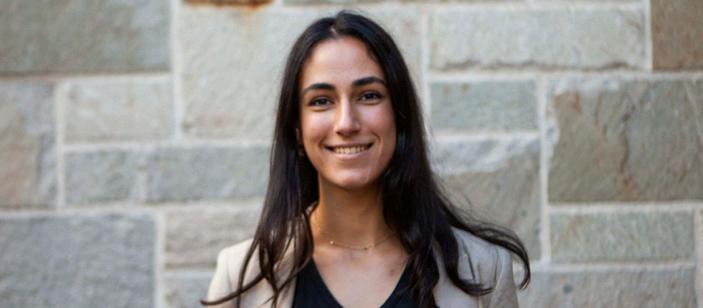
violent war.
e Star Wars prequel trilogy is often remembered for its disastrous special e ects, horrible writing, and the atrocity that was Jar Jar Binks. And yeah, it should be remembered for these things, but I’m here to tell you that there is so much more to the trilogy. Hiding beneath distractingly bad elements are the best political dramas out there. e prequels are all about painting a picture of a world of corruption and lies, and the best part about it is when it all comes crashing down in Revenge of the Sith
As the Emperor’s plot unfolds, we can see how deep Palpatine has his roots in the Galactic Republic and how impossible it is that he will be unrooted before his evil plot unfolds. We nd out that the Jedi are too blinded by pride to defend the realm they are sworn to protect. It’s genius, really. anks to the originals, we believe that the Jedi are good and confused as to why they aren’t around anymore. So when we are introduced to the Jedi’s corruption, greed, and sel shness, we are shocked as we are forced to watch the downfall of a once honorable organization with good intentions. And the Jedi’s greed isn’t obvious either. ey don’t ght for money or glory, or evilly rub their hands together while smirking. Instead, we see their evil when they separate Force-sensitive children from their families. We see their evil when they refuse to change their ways for the better. We see their evil when they keep secrets for their bene t or when they’re wrapped up in an unnecessarily long and
What helps build the world of the prequels even more is the television series Star Wars: e Clone Wars e Clone Wars reveals the war that occurs between the second and third lm installments, and we see the consequences rsthand in greater, more devastating detail. In the series we get to visit Separatist sympathizers and discuss viewpoints with them, see how more worlds are a ected by the war, and how a violent war turned children into soldiers too soon. Truly, every Star Wars fan should watch e Clone Wars, which make the prequels even better.
But, I digress. e prequels tell the origin story of one of the most iconic and feared villains in lm history, while simultaneously telling the story of the collapse of a well-de ned society and its moral and respected peacekeepers. When you look at the prequels through this lens, which many forget because they expect and want more of what the originals gave them, you can respect so much more. George Lucas was able to create two trilogies that are intricately connected but very di erent in genre. I implore you to watch the prequels without the expectation of more lms like the original trilogy. You will be able to appreciate the story so much more.
e prequels add doubt and shine a negative yet societally realistic light on characters revered in the originals. In e Empire Strikes Back, we meet a wise yet a little crazy Yoda, who seems to know all there is to know about the Force. But when we meet him in the prequels, he is a bureaucrat who is too swept up in war and politics to face the looming threat right under his nose. It’s clear that he learned from who he was, and we can even see him start to undergo this transformation at the end of Revenge of the Sith. Obi-Wan, as well, is less blinded than Yoda, but still bound to the bureaucratic Jedi Order, far more so than Anakin. Obi-Wan’s story is
tragic. He loses everything he loves all in one movie, and he is powerless to stop it. In theory, ObiWan represents the best the Jedi Order could be. He is honest and loyal to the Order and its ways, but he can disobey if he sees t, though not as quickly or eagerly as Anakin. He is a balanced Jedi in power, yet privy to the downfall of an organization he dedicated his entire life to. All of his friends die, he has to ght his brother (who betrayed him), and he must live with the guilt of being a survivor. We could have never imagined such an in-depth backstory from the scenes of an elderly Obi-Wan in the originals. He is given so much more depth and emotion, and all of that characterization adds to the originals, too. It makes everything so much more emotional.
e prequels could be considered a ctional version of our society. We are all easily manipulated and ultimately somewhat powerless to stop events like the overthrow of our republic. We can listen and learn from the prequels and keep a stricter eye out. We can double and triple check who we are looking to for policing or moral guidance, and we can try our best not to be blinded by our own arrogance. One of my favorite lines from Revenge of the Sith (there are so many) is as Chancellor Palpatine is given emergency powers and the Senate crowd roars, Padmé, a Galactic Senator and total badass, says, “So this is how liberty dies, with thunderous applause.” Societies can fall, and with the stories of the originals, they can even be reborn more just.
In conclusion, the prequels are home to horrors like Jar Jar Binks and poop jokes, but over the course of three movies they give us a relevant and engaging story of a society, its moral corruption, and its eventual downfall. So, please give the prequels a chance because they really are brilliant.



BC students are by their very nature intellectuals. So of course it makes sense that games like the New York Times Crossword puzzles and various sudokus are attractive to such an academically inclined population of young adults. And with the arrival of a new brain game sensation that’s gripping the nation, hardly a student around can be caught without their nose in their phone, gears turning in those big brains as they try to gure out which ve-letter word will satisfy their brain game craving of the day. Wordle, the latest word game craze, is a 5x6 grid where players must essentially ll in their guess for the word of the day e satisfaction gained from guessing the word in fewer and fewer amounts of time is unmatched.
e beloved Honey Q returned to dining halls this week … with some changes that severely altered the once religious experience of eating that heavenly bowl of rice, ranch, and that sweet yet tangy, crunchy yet moist, and colorful yet appealing-to-the-eye chicken. Once a bowl loaded with ingredients, now the ever-favored Honey Q bowl has reentered the dining hall circuit in a skimpy new form: the Honey Q 2.0: e Wrap. A single measly scoop of those sublime poultry nuggets, a paper thin spread of that zesty ranch, and some measly lettuce shreds are now all you get when you build your own Honey Q wrap. Where is the beloved bowl that once was?

Whoever has been on aux in Mac recently is going through something. Everything from e Lumineers to what sounded like the Pirates of the Caribbean soundtrack was playing on full volume over the speakers this week, perhaps in an attempt to drown out the already raucous sounds of students chatting, laughing, and munching. e discrepancy between e Lumineers and Jack Sparrow is already pretty concerning, so sending love to whoever is working out their feelings via the Mac speakers. On the plus side, whoever is on aux in Coro seems to have their life gured out, so keep on playing that Taylor Swift!




Late in the second quarter of Boston College women’s basketball’s matchup against Virginia Tech, senior guard Cameron Swartz fouled Virginia Tech’s Emily Lytle after a rebound about 15 feet from the Hokies’ basket. Swartz immediately looked up in frustration, attempting but failing to argue the call with the referee. With the Hokies in the bonus, Lytle knocked down two free throws.
Swartz’s foul was representative of BC’s performance Sunday, as foul trouble and 36.1 percent shooting led Virginia Tech (16–6, 8–3 Atlantic Coast) to defeat the Eagles (15–8, 6–6) in Blacksburg 85–62.
Foul trouble plagued the Eagles all game, as BC committed 29 fouls
made 31 of its 33 free-throw attempts on 93.9 percent shooting from the line. BC’s starters accounted for 17 of BC’s 29 fouls—four each for Swartz, Ally VanTimmeren, and Maria Gakdeng, and five for Taylor Soule, who fouled out midway through the fourth quarter.
BC finished 13-of-19 from the free-throw line, and its bench players—who saw more playing time due to starters in foul trouble—finished with 20 points.
“[We] couldn’t really play the lineups that we wanted to play because we were in foul trouble,” head coach Joanna Bernabei-McNamee said after the game.
With Gakdeng seeing limited minutes due to fouls, Virginia Tech worked down low, and center Elizabeth Kitley scored 27 points.
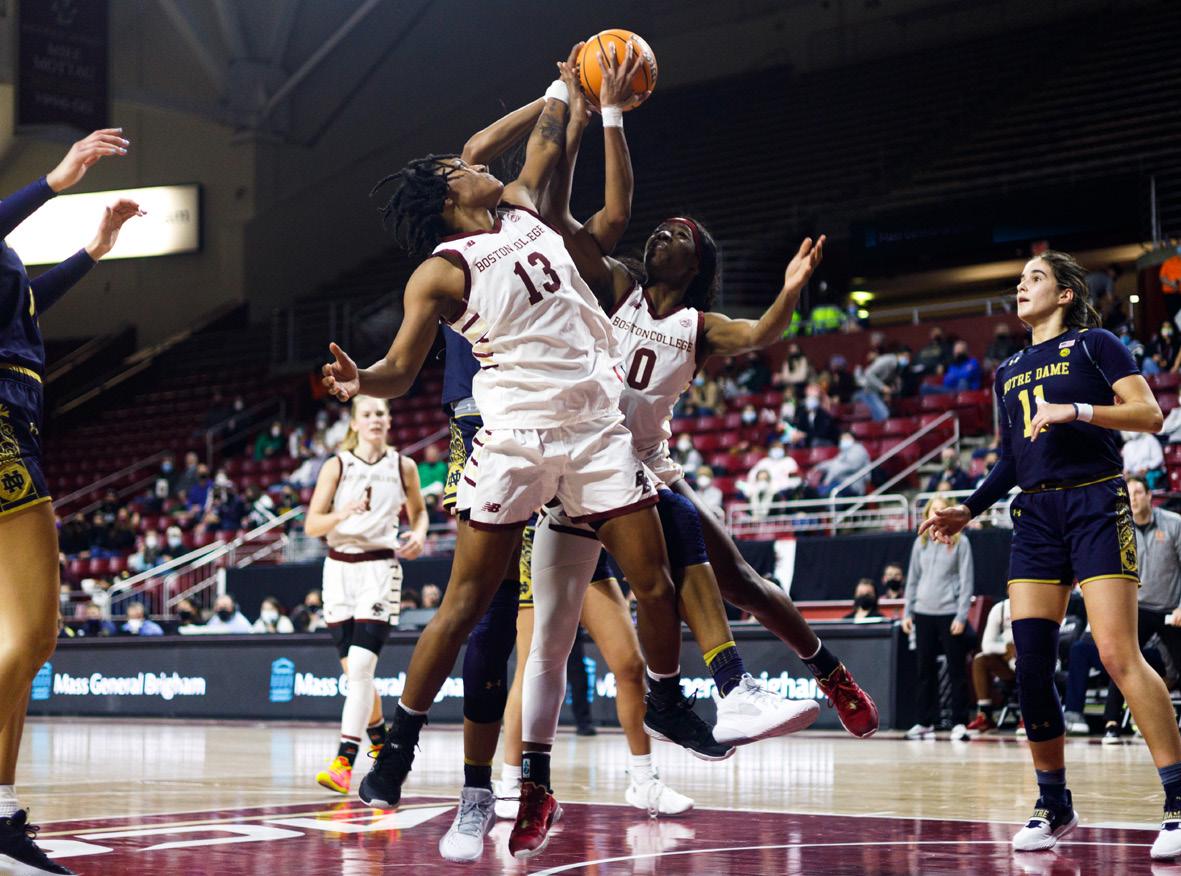
“I thought Kitley had an amazing
played really well both on the freethrow line … and she hit her little eight-footers. … Virginia Tech played a heck of a game.”
The Hokies outperformed BC in most categories on the stat sheet, and the Eagles trailed all night in the loss. Along with recording half of the fouls that BC did, Virginia Tech shot 10 percent better from the field and scored 28 points in the paint compared to BC’s 24.
Three Eagles finished in double figures, with Swartz, Makayla Dickens, and Soule finishing with 18, 14, and 13 points, respectively. Dickens scored three of her four field goals from 3-point range, finishing 3-of-7 from behind the arc.
BC continued to turn the ball over, as it has all season, recording 16 turnovers on the night.
“Offensively, we lacked a lot of
Coming o a loss to Harvard on Tuesday night, Boston College men’s hockey was looking to snap its eightgame losing streak in its matchup against No. 14 UMass Lowell on Friday.

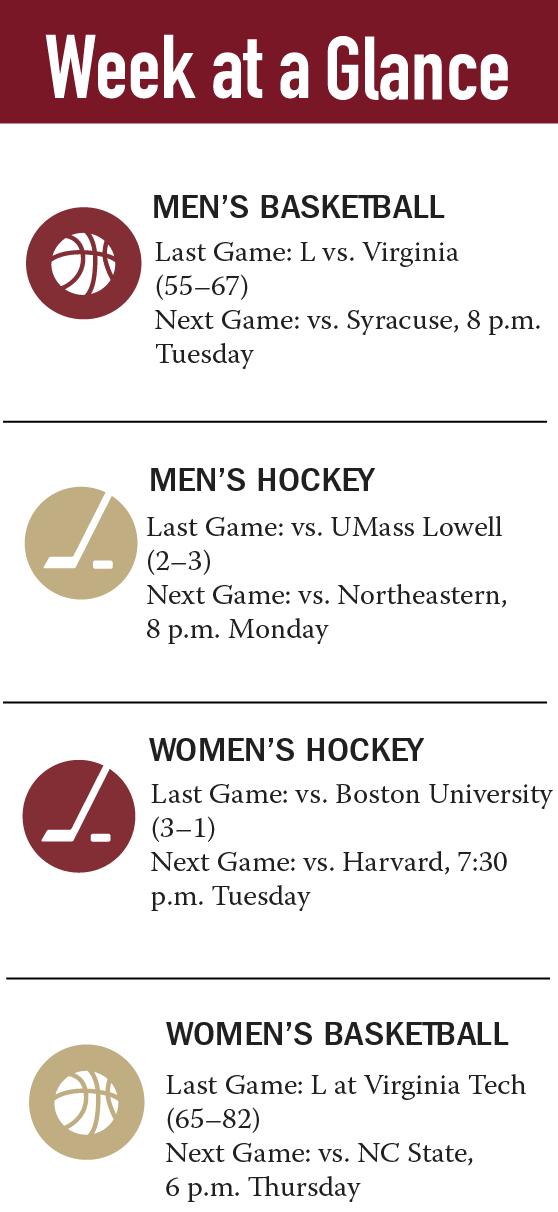
But in its nal game before the Beanpot, BC (10–13–4, 5–9–3 Hockey East) let a one-goal lead slip and fell 3–2 to UMass Lowell (15–6–3, 12–5–1) for the second time this season.
UMass Lowell pushed a fast pace of play early, but BC maintained control. Without starters Marc McLaughlin, Drew Helleson, and Jack McBain, who are competing in the 2022 Olympic Games, a number of Eagles step up in their absence. Gentry Shamburger opened the scoring o a pass from Trevor Kuntar for his rst career goal.
UMass Lowell responded 12 minutes later to tie the game at one.
The first penalty of the game, called on UMass Lowell’s Brehdan Engum for high sticking in the ninth minute of the second period, sent BC on its rst power play of the night.
Immediately after the River Hawks’ penalty kill, Brandon Kruse drew the second penalty of the night for hooking, sending UMass Lowell on the one-man advantage. BC remained in control of the puck in the o ensive zone for the duration of its penalty kill, though, and left the period where it started: tied 1–1.
e Eagles entered the third period with high energy, and the two teams continued their fast pace of play. Just under two minutes into the nal frame, o cials sent Brian Chambers to the penalty box for interference.
On the power play, Kuntar took control and slipped the puck just above the glove of UMass Lowell goaltender Owen Savory to put the Eagles up 2–1.
The
BC’s o ense remained in control and returned to the power play when UMass Lowell received a penalty in the ninth minute of the nal frame.
UMass killed the penalty, though, as Owen Cole scored a shorthanded goal
to tie the game at 2–2.
With just 1:45 left in the game, the Riverhawks scored again to make it 3–2 for UMass Lowell’s rst lead of the game. BC responded by pulling goaltender Eric Dop for an extra skat-
er, but the Eagles could not answer, and UMass Lowell left Conte Forum with a win.
BC hasn’t won a game since its victory over Dartmouth in the Ledyard Classic on Dec. 31.
One minute into Saturday’s matchup between Boston College women’s hockey and Boston University, Gaby Roy had set the tone.
The sophomore forward tapped in a shot-pass at the right post to score the game winner for BC almost before the game had begun.
“BC [versus] BU is never a hard game to get fired up for,” Roy said. “I think putting that one in early definitely set the tone and kind of got everyone riled up on the bench just to shut them down in the first period.”
BC (17–11, 14–8 Hockey East) scored two more unanswered goals
and defeated the Terriers (10–11–5, 9–7–4) by a final score of 3–0 to split the Battle of Commonwealth Ave. after losing to BU earlier this season.
“Obviously, I thought that was a really good game for us,” head coach Katie Crowley said after the game. “I thought we played well in all facets of the game, offensively, defensively, [and in the] neutral zone.”
Defensively, the Eagles were disciplined all night. BC goaltender Abigail Levy kept a clean sheet, recording 32 saves for her first shutout of the season.
“It’s all credit to my team,” Levy said. “I think we’re playing some of the best hockey games we’ve played all year. … I wouldn’t be able to get that shutout without all those players who blocked those shots and
protected me down low.”
Both teams struggle to convert on power-play opportunities in the second and third periods. Both defenses shut down their opponents’ offense when down a man, and neither team converted in their combined five power plays in the final two periods.
Thirteen minutes into the second period, while at even strength, Abby Newhook scored off a no-look pass from Kelly Browne to put the Eagles up 2–0 heading into the final frame.
Roy scored her second goal of the game in the third period, giving the Eagles a three-goal lead.
“I just ended up being alone in front of the net,” Roy said. “Kind of like right place, right time. … Crashing the net has been successful for
us this year, so I kind of just keep doing that, and it’s been working for our team.”
The Terriers dominated other areas of the stat sheet, finishing the game with 52 shots compared to BC’s 40 shots, and 32 shots on goal compared to the Eagles’ 30 shots on goal.
The win puts the Eagles on a seven-game win streak, the longest they’ve had this season, and BC will look to extend the streak as it faces Harvard in the Beanpot final on Feb. 8.
“I’m really happy with the way we played and with the weekend overall,” Crowley said. “Those are two huge league games for us, and we found a way to finish in the middle of the Beanpot and at an exciting time.”
Coming off a victory in the first round of the Beanpot on Tuesday, Boston College women’s hockey built o its momentum at the Whittemore Center Arena against New Hampshire on Friday. BC (16–11, 13–8 Hockey East) held o three power plays from New Hampshire (9–16–2, 7–12–1) to extend its win streak to six games with a 5–3 victory over the Wildcats.
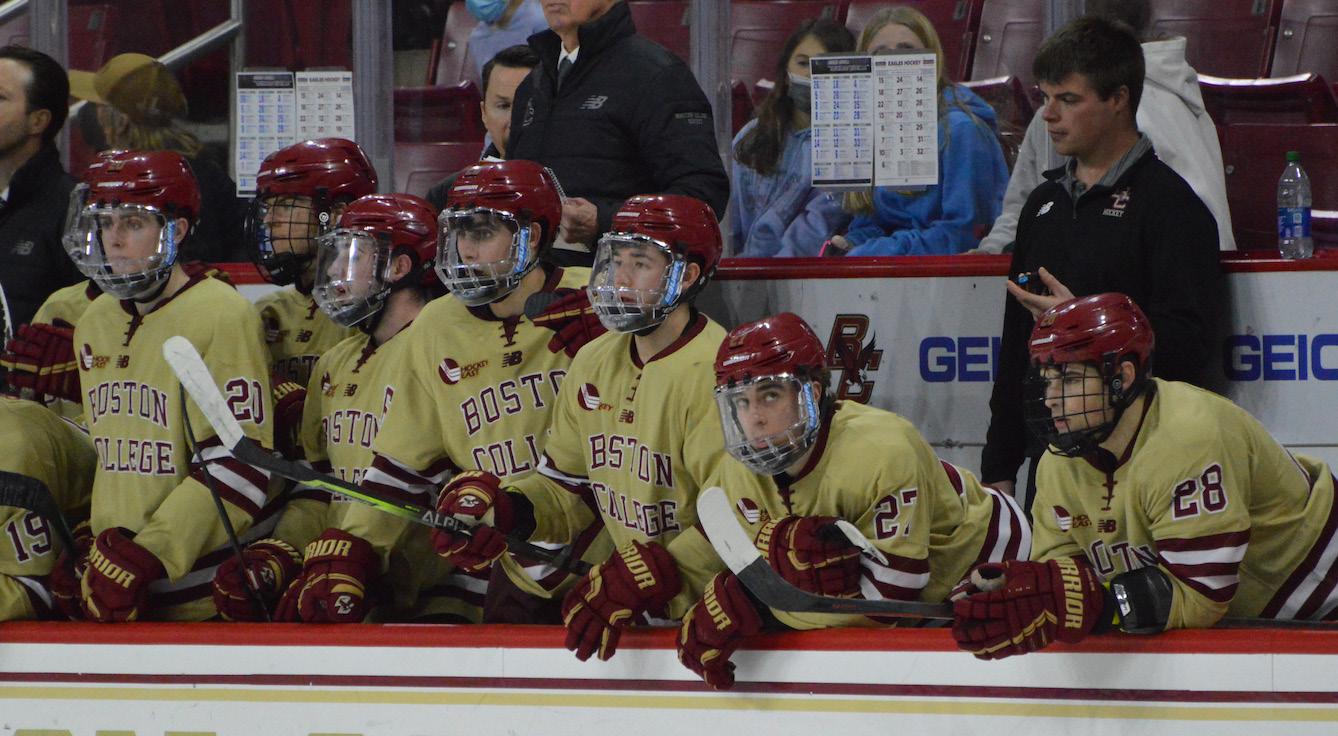
e Eagles dominated in forechecking and puck possession in the first period, but New Hampshire’s Tamara Thierus broke open the scoring with just over eight minutes remaining in the frame. After the goal, o cials sent Sidney Fess to the penalty box for a hooking call, putting the Eagles down a goal and a man.
BC maintained its composure, and shortly after the penalty kill, Abby Newhook buried a shot to knot it up at
1–1. Alexie Guay and Kelly Browne were credited with assists. Guay totaled three assists, and Browne scored one goal and made two assists to give both Eagles a three-point outing.
Alongside Newhook, Browne, and Guay, Hannah Bilka kept energy up for the Eagles. On her second assist of the night, Guay fed a pass to Bilka who drove to the net and nished on New Hampshire goaltender Ava Boutilier to claim a 2–1 lead to close out the period.
e Wildcats threatened a comeback in the second frame, but a number of saves from Abigail Levy maintained BC’s lead. BC held New Hampshire scoreless during a penalty kill three minutes into the period. Caroline Go redo followed it with a goal to make it 3–1 just 30 seconds after the Eagles returned to even strength.
Shortly after, Browne struck again on an assist from Bilka, to put the Eagles up 4–1. Facing a three-goal de cit, the Wildcats replaced Boutilier with Nicky Harnett with 12:47 left in the second period.
The
Aggressive play characterized the remaining minutes of the second period, as New Hampshire took more penalties.
e Eagles went on a two-man advantage with under three minutes to go in the second frame. BC prevented a frustrated New Hampshire from gaining momentum, and a penalty on New Hampshire’s Kyla Bent with 28 seconds left in the
frame put the Eagles on the power play to start the third period.
Momentum began to shift for New Hampshire in the third, though, as Nicole Kelly split BC’s defense o a seam pass through center ice from Marina Alvarez, putting the Wildcats back on the board at 4–2. Kelly scored her second goal of the night four and a half minutes later to pull
New Hampshire within one goal at 4–3.
New Hampshire’s third-period e ort was too little, too late, though, and BC took advantage of a power-play opportunity where Michaela Boyle scored an unassisted goal—her rst of the season— to put the Eagles up 5–3.
After killing o a late penalty, BC walked away with its sixth win in a row.